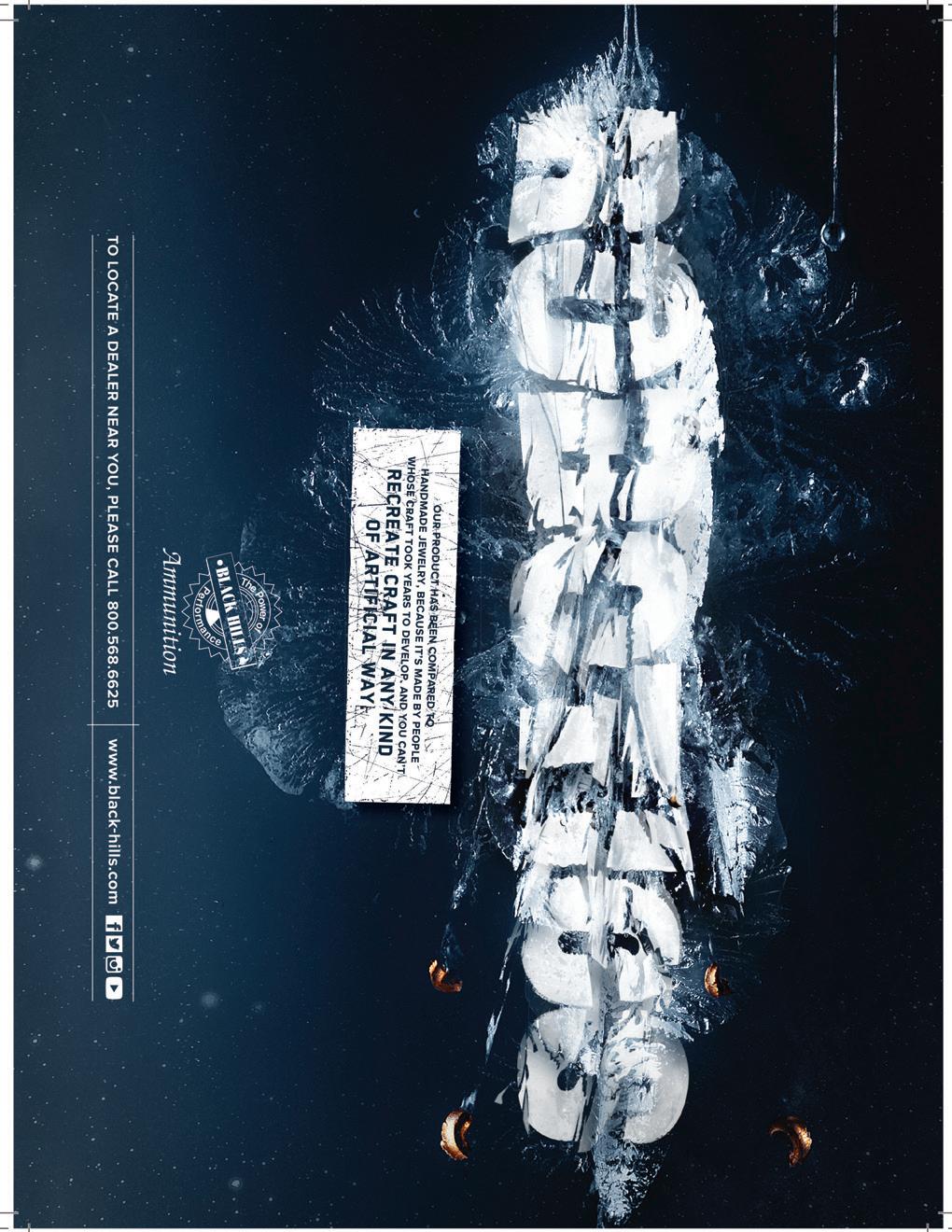


THE PREMIER SPORTING GOODS STORE ON PRINCE OF WALES ISLAND
FOR ALL YOUR FISHING, HUNTING, AND CAMPING NEEDS! KNOWLEDGEABLE STAFF WILL LET YOU KNOW WHERE, WHEN AND HOW!









THE PREMIER SPORTING GOODS STORE ON PRINCE OF WALES ISLAND
FOR ALL YOUR FISHING, HUNTING, AND CAMPING NEEDS! KNOWLEDGEABLE STAFF WILL LET YOU KNOW WHERE, WHEN AND HOW!





Nestled in the foothills of the Ozark Mountains in Missouri, High Adventure Ranch offers all of the excitement of western big game hunting without the costs and hassles.
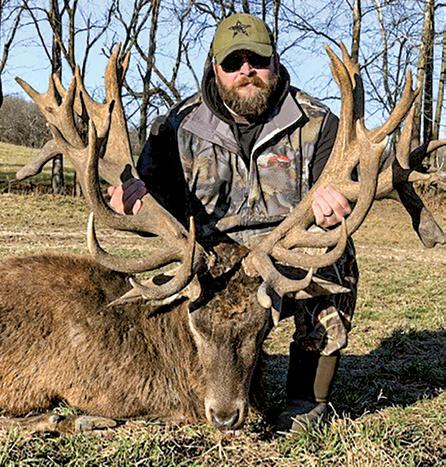


Be prepared for a fair chase hunt! With over 3 square miles of prime natural habitat, our ranch provides challenges to even the most seasoned hunter, but our experienced guides and “No Game, No Pay” policy practically ensure that you won’t go home empty handed. In addition, High Adventure’s hunting season is year-round, allowing ample time to fit the most demanding schedule.
While our whitetail, elk, wild boar and red stag hunts top our hunter’s most popular lists, hunters from around the world have visited our ranch, hunting everything from American bison, black buck, fallow deer to Spanish goats and African game.
So, whether you desire a 10-point whitetail mount for your trophy room or simply the thrill and challenge of taking down one of our many elusive big game animals, High Adventure Ranch guarantees memories of an unparalleled hunting experience that will bring you back again and again.



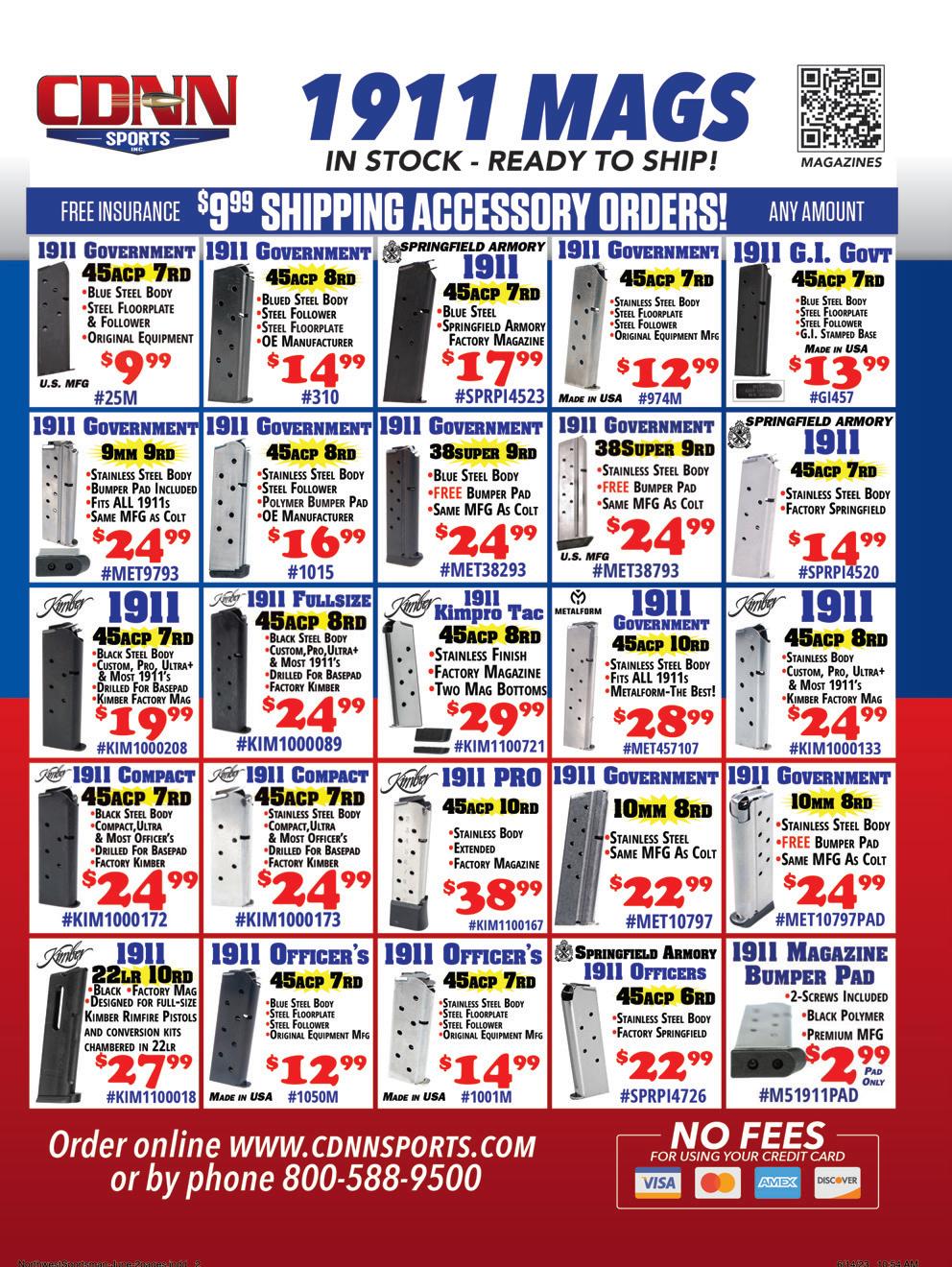









Volume 12 // Issue 10 // July 2023
PUBLISHER
James R. Baker
GENERAL MANAGER
John Rusnak
EDITOR-IN-CHIEF
Andy Walgamott
OFFICE MANAGER / COPY EDITOR
Katie Aumann
LEAD CONTRIBUTOR
Frank Jardim
CONTRIBUTORS
Jason Brooks, Larry Case, Scott Haugen, Phil Massaro, Mike Nesbitt, Paul Pawela, Nick Perna
SALES MANAGER
Paul Yarnold
ACCOUNT EXECUTIVES
Lucas Hoene, Mike Smith, Zachary Wheeler
DESIGNER
Lesley-Anne Slisko-Cooper
PRODUCTION ASSISTANT
Kelly Baker
WEBMASTER / INBOUND MARKETING
Jon Hines
INFORMATION SERVICES MANAGER
Lois Sanborn
ADVERTISING INQUIRIES ads@americanshootingjournal.com
Anthony Imperato and his father Louis
Imperato founded Henry Repeating Arms in the mid-1990s and have sold millions upon millions of lever-action rifles and other firearms, while the company’s Guns for Great Causes program has donated millions of dollars to charitable organizations. (HENRY REPEATING ARMS)

Website: AmericanShootingJournal.com

Facebook: Facebook.com/AmericanShootingJournal
Twitter: @AmShootingJourn
MEDIA INDEX PUBLISHING GROUP 941 Powell Ave SW, Suite 120, Renton, WA 98057 (206) 382-9220 • (800) 332-1736 • Fax (206) 382-9437 media@media-inc.com • www.media-inc.com
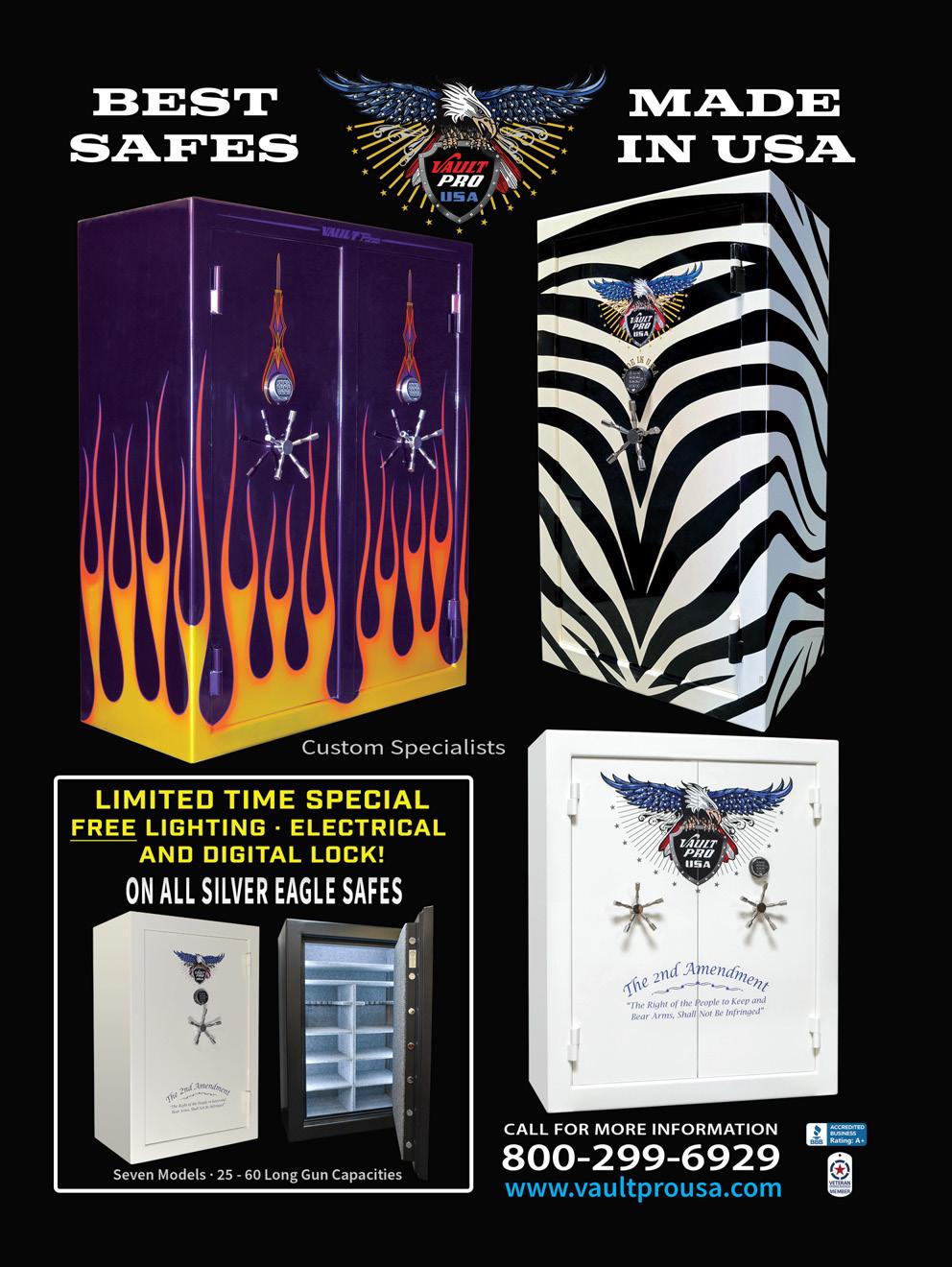
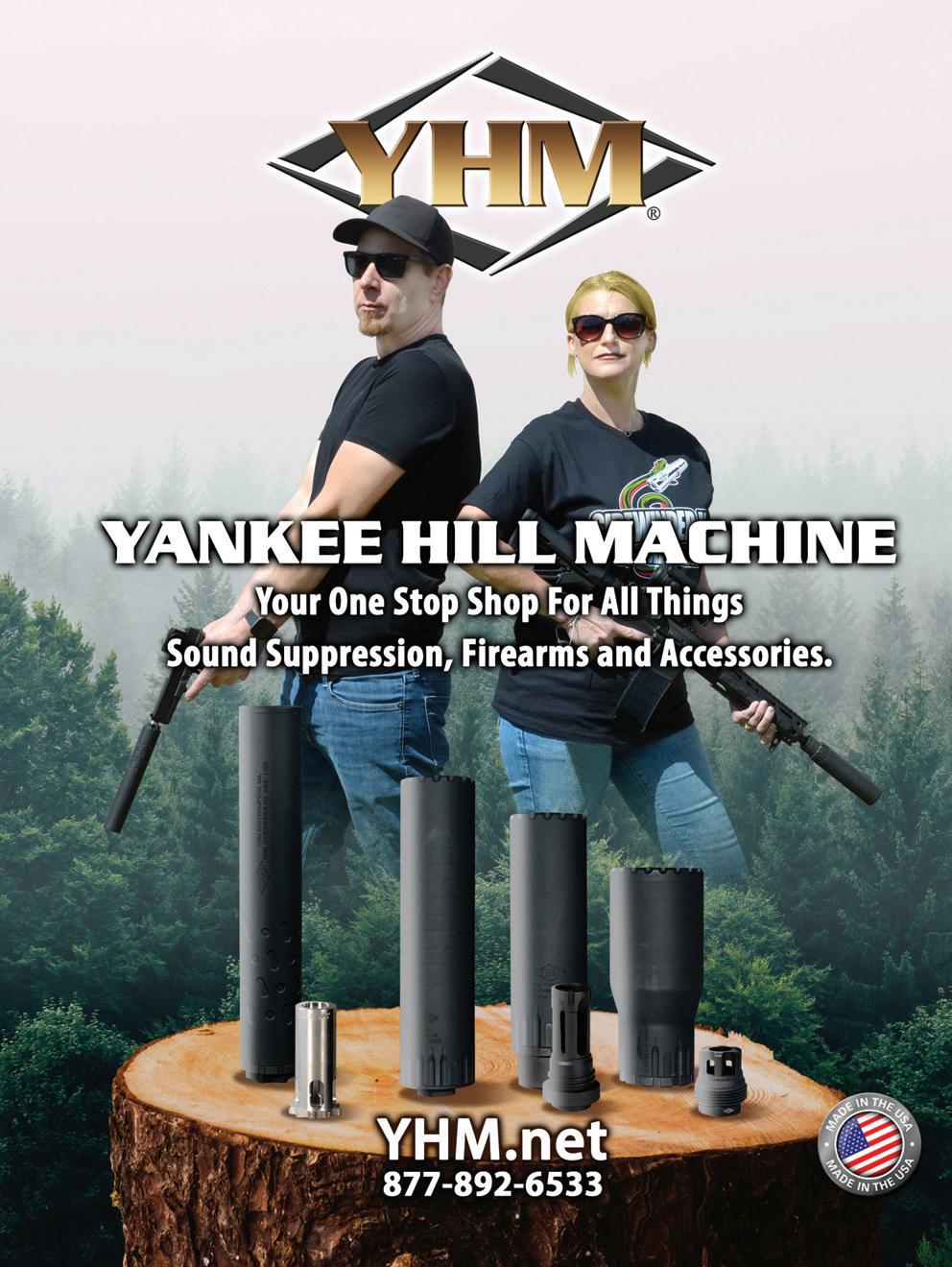
38 11 INSPIRING QUOTES ON WHAT IT MEANS TO BE AN AMERICAN
Words of wisdom from George Washington, Abraham Lincoln, Harry S. Truman and other famous Americans.
41 5 FAMOUS FLAGS
As we celebrate the 247th anniversary of America’s founding this month, Frank Jardim takes a look back at the history of some of our Red, White and Blue banners.
47 BULLE T BULLETIN: THE BULLDOZERS FROM SOUTH DAKOTA
It’s a long way from the hunting grounds of the Dakotas to upstate New York, but our professor of projectiles Phil Massaro details a couple lines of Badlands Precision copper bullets that will do you good in wide-open places and tight spaces.

58 ROAD HUNTER: DOVE SEASON PREP FOR YOU AND YOUR DOG
One of fall’s earliest bird hunts is just around the corner, and now’s the time to get ready to down and retrieve speedy mourning doves. Scott Haugen has tuneup tips for yourself and your gun dog.
69 SC ATTERGUN ALLEY: Q&A WITH THE SHOTGUN GUY
Larry Case isn’t one to back down from a challenge, and this issue he tackles a pair of pretty thorny questions. Find out what he has to say about whether Remington 870s or Mossberg 500s are a better bird gun, and if a hand-medown Browning A5 from Gramps is still worth hunting with.
77 L AW ENFORCEMENT SPOTLIGHT: REMEMBERING K9 HUDSON
It’s not just policemen and -women on the front lines protecting us from dangerous criminals – canine cops are on duty as well and face the same risks. Nick Perna shares the story of an Illinois K9 that gave it all.
79 SELF-DEFENSE TRAINING: DEADLY FORCE ENCOUNTERS WITH DEADLY GANGSTERS
Paul Pawela offers up some thoughts on selfdefense through the lens of the hunt for 1930s bank robbers and murderers Bonnie and Clyde.
Henry Repeating Arms has successfully harnessed the aura of the Old West over the past quarter of a century with its lever-action rifles and other firearms, while also embracing a modern philanthropic mission benefitting cancer-stricken children and their families, conservation and gun safety, among other noble causes. Jason Brooks shares the firearms company’s story.




99 BL ACK POWDER: NEW BLOOD AT BUFFALO CAMP
Fresh faces – young and old alike – added spice to a black powder cartridge club’s annual matches this spring. Mike Nesbitt highlights the new shooters, the unique rifles they shot and how they fared at Buffalo Camp 2023.
91 SUCCESS MOUNTS FOR FIREARMS ACCESSORY COMPANY
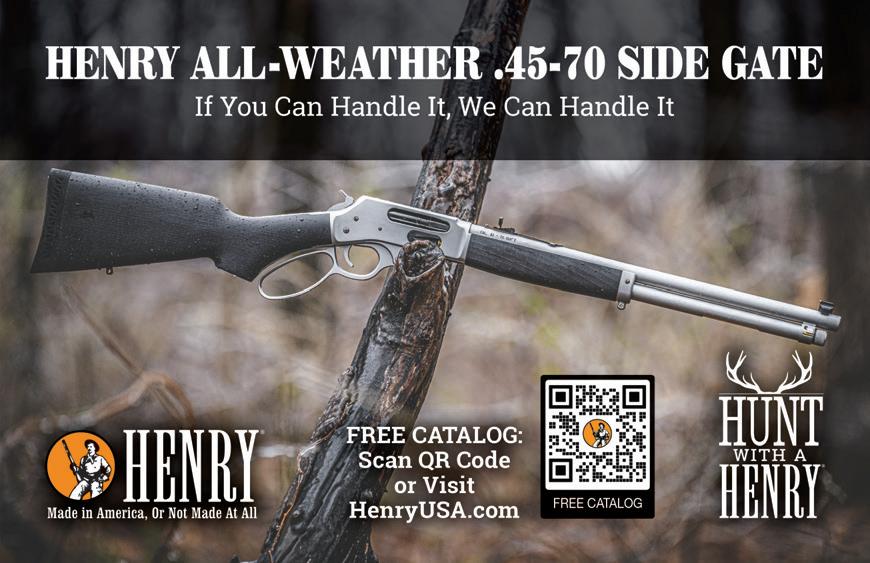

UM Tactical, with its sight mounting systems, Boltaron holsters, RAGE TCS compensators and more, is planning big expansions in the market and at its new Florida manufacturing facility.
21 Gun Show Calendar
25 Competition Calendar
27 Precision Rifle Series Schedule, Recent Results

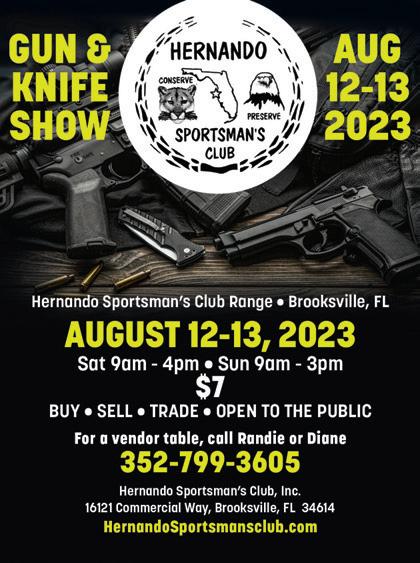

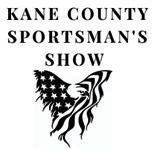

AZ Gun RAdio azgunradio.com
July 7-9 Kingman, Ariz. Beale Celebrations
July 8-9 Orange, Calif. American Legion
July 22-23 Phoenix, Ariz. Ben Avery Shooting Facility Air Gun Building
July 22-23 El Paso, Texas Forum Ballroom
July 28-30 Casa Grande, Ariz. Casa Grande Event Center
August 5-6 Tucson, Ariz. Tucson Expo
August 18-20 Albuquerque, N.M. The Lodge
August 19-20 Mesa, Ariz. Ar ya Reception Hall
C&E Gun Shows cegunshows.com
July 15-16 Concord, N.C. Cabarrus Arena & Events Center
July 15-16 Salem, Va. Salem Civic Center
July 29-30 Fayetteville, N.C. Crown Expo Center
Constellations, Inc. kcsshow.com
September 17 Woodstock, Ill. McHenr y County Fairgrounds
October 8 St. Charles, Ill. Kane County Fairgrounds
October 22 Woodstock, Ill. McHenr y County Fairgrounds
November 12 St. Charles, Ill. Kane County Fairgrounds
November 19 Woodstock, Ill. McHenr y County Fairgrounds
December 10 St. Charles, Ill. Kane County Fairgrounds
December 17 Woodstock, Ill. McHenr y County Fairgrounds
Crossroads Of The West Gun Shows crossroadsgunshows.com
Florida Gun Shows floridagunshows.com
July 15-16 Phoenix, Ariz. AZ State Fairgrounds
July 22-23 Reno, Nev. Reno Convention Center
July 8-9 Orlando, Fla. Central Florida Fair Grounds
July 15-16 Miami, Fla. Miami-Dade Fairgrounds
July 22-23 Palmetto, Fla. Bradenton Convention Center
G&S Promotions gunshowtrader.com
July 8-9
Mountain Home, Ark. Baxter County Fairgrounds
July 15-16 Elk City, Okla. Elk City Civic Center
July 28-30
August 5-6
August 11-13
August 19-20
August 26-27
September 16-17
September 22-24
Nacogdoches, Texas Civic Center
Heber Springs, Ark. Community Center
Canton, Texas Canton Civic Center
Conway, Ark. Conway Expo Farigrounds
Marshall, Texas Marshall Convention Center
Henderson, Texas Rusk County Expo Center
Nacogdoches, Texas Nacogdoches County Expo Center
Sept. 30-Oct. 1 Hot Springs, Ark. Garland County Farigrounds
To have your event highlighted here, send an email to kaumann@media-inc.com.
Hernando
RK


Real
Tanner
Wes

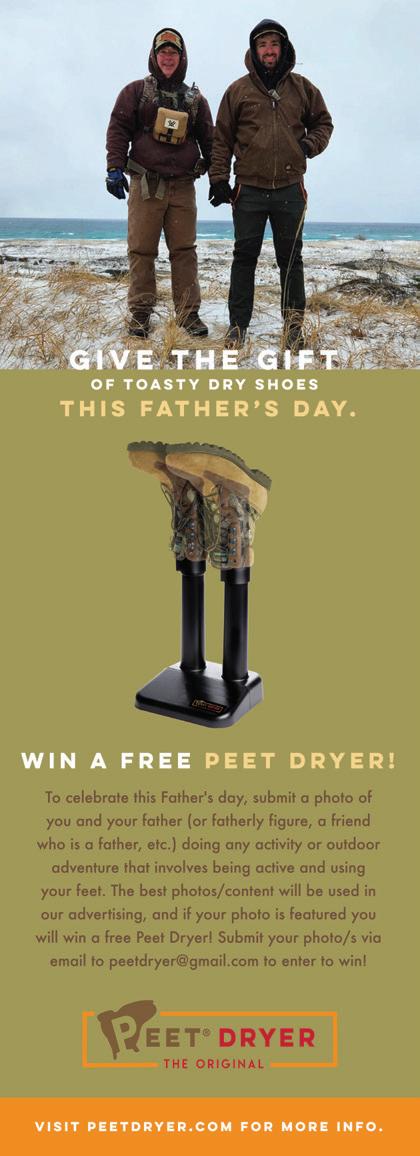

July 6-11
Rifle Pan Am Selection Match 2
Colorado Springs, Colo.
July 7-9
Utah July 2023 PTO
Salt Lake City, Utah
July 8-9
Alaska USPSA Section Championship


Chugiak, Alaska
July 14-16
Area 7 Championship Hampden, Maine
July 15-16
Vortex Wisconsin Sectional Championship
Rhinelander, Wis.
July 8-9
Scarborough Fish & Game
Annual GSSF Match
Scarborough, Maine
July 8-9
Couer d’Alene Glock Classic
Couer d’Alene, Idaho
July 15-16
Buckeye State Ballistic Challenge
Wingett Run, Ohio
July 6
Nebraska State Shoot
Litchfield, Neb.
July 8-9
NH State Championship
Athol, Mass.
July 14-16
Mid-Central Regional Championship
Festus, Mo.
July 14-16
Pennsylvania State IDPA Championship
Hunlock Creek, Pa.
July 22-23
Washington State IDPA Championship
Puyallup, Wash.
July 8
MRC Smallbore 3-P and Prone Elk River, Minn.
July 29-August 3
Pistol Pan Am Selection Match 2 Colorado Springs, Colo.
July 19-23
Federal USPSA Multi-Gun National Championship Forest Lake, Minn.

July 27-30
Berry’s Area 1 Championship Billings, Mont.
July 28-30
Western PA Section Championship Bulger, Pa.
July 15-16
Northwestern Regional Classic Port Townsend, Wash.
July 22-23
Great Lakes Regional Classic Brighton, Mich.
July 22-23
Pacific Coast Challenge
Shedd, Ore.
July 21-22
Georgia State Championship
Rainsville, Ala.
July 22-23
Montana State Championship
Lincoln, Mont.
July 27-30
CMSA Lakota Western US Championship
Las Vegas, Nev.
July 28-30
Georgia State IDPA Championship
Dawsonville, Ga.
July 29
Iowa State IDPA Championship
Elkhart, Iowa
To have your event highlighted here, send an email to kaumann@media-inc.com.
August 11-13
Utah August 2023 PTO Salt Lake City, Utah
August 10-13
Area 3 Championship Alda, Neb.
August 12-13
Columbia Cascade Sectional Shedd, Ore.
August 25-26
Greater Yellowstone Section Championship Roundup, Mont.
July 29-30
Virginia Ballistic Challenge Bluefield, Va.
August 5-6
Ontario Region Glock Challenge
Ontario, N.Y.
August 5-6
RSC Glock Shoot Out Rawlins, Wy.
August 5
Indiana State Shoot
Huntington, Ind.
August 6
Michigan State Shoot
Huntington, Ind.
August 10-11
Missouri State Fair Classic
Sedalia, Mo.
August 4-5
Steel City Shootout Bulger, Pa.
August 13
Michigan State Match Dorr, Mich.
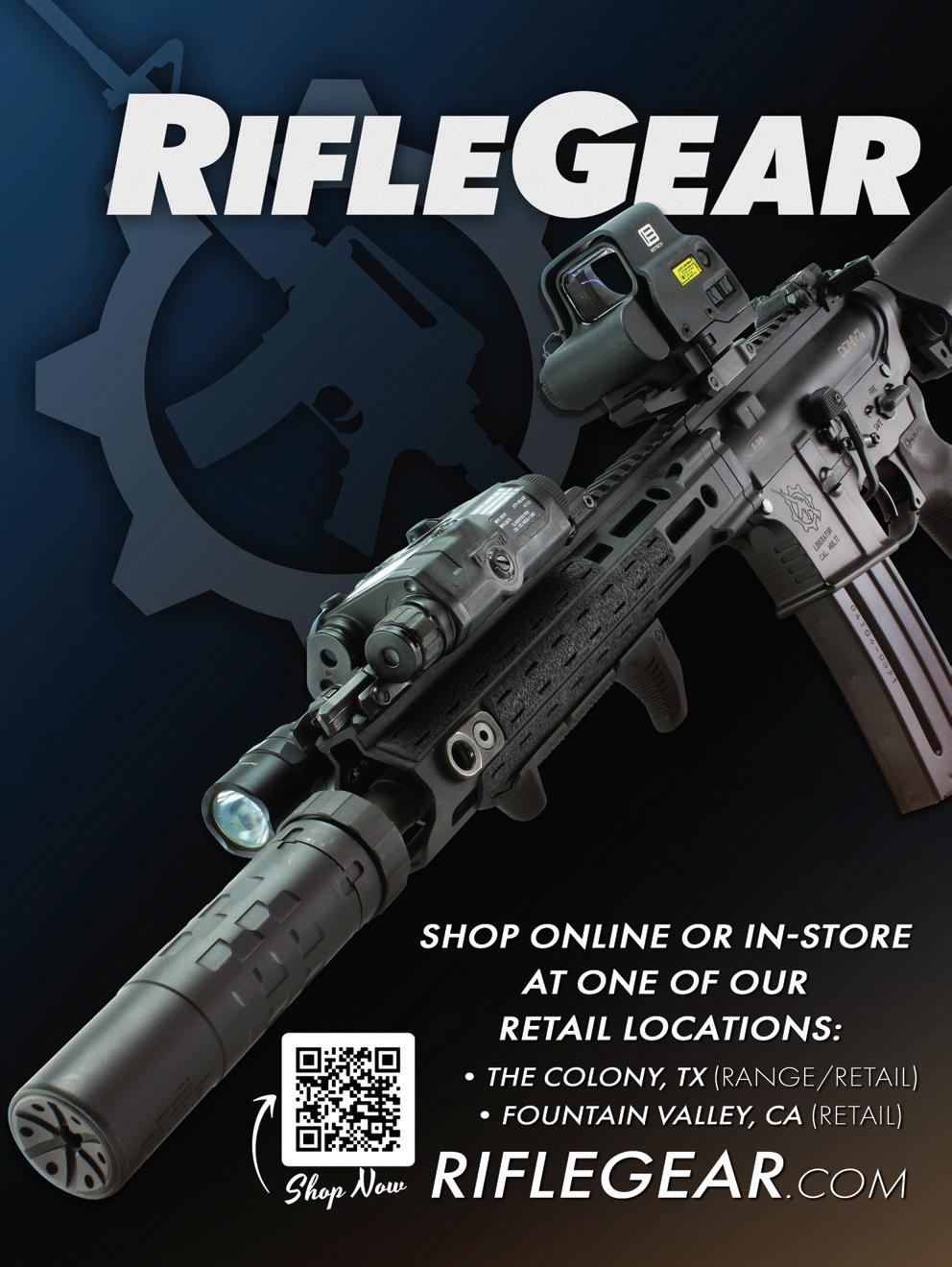
July 8
2023 Hodgdon Punisher Positional
July 15 THS Steel Challenge

July 15
July 22
July 28
Twisted Barrel Scorcher
Sheepdog Showdown
Blue Mountain Revival
July 29 2023 Hoosier Hellfire
August 5
August 12
August 12
August 19
August 26
September 2
Silent Night
Conway Springs, Kansas
Fort Pierre, South Dakota
Little Rock, Arkansas
Catskill, New York
Vernal, Utah
Butlerville, Indiana
Ninnekah, Oklahoma
RCBS Rumble Pleasant Hill, Missouri
Peterson Cartridge Challenge Kennerdell, Pennsylvania
Magnolia Meltdown Carthage, Mississippi
W.A.R. Rifles Shootout Tremont, Pennsylvania
Alpha Munitions Nut Crusher Price, Utah
September 2 W.A.R. Rifles Shootout Tremont, Pennsylvania

September 9 2023 Federal Gold Medal Match Carbon Hill, Alabama
For more information visit www.precisionrifleseries.com

H.A.M.
Rocky Mount, Virginia
June 3, 2023
1st Place ANDY SLADE Open Div.
174.000/100.000
2nd Place
KEN SANOSKI Open Div.
170.000/97.701
3rd Place
KAHL HARMON Open Div.
168.000/96.552

Prosser, Washington
June 10, 2023
1st Place
NICK GADARZI Open Div.
187.000/100.000
2nd Place
CLAY BLACKKETTER Open Div.
184.000/98.396
3rd Place
BRIAN NEACE Open Div.
172.000/91.979

Evanston, Wyoming
June 23, 2023
1st Place
AUSTIN ORGAIN Open Div.
167.000/100.000
2nd Place
KEITH BAKER Open Div.
161.000/96.407
3rd Place (tie)
AUSTIN BUSCHMAN Open Div.
JAKE MILLARD Open Div.
159.000/95.210

Henry Repeating Arms is a company known for more than just quality lever-action rifles, shotguns and – new – revolvers. From its inception more than 25 years ago, Henry has had a strong commitment to giving back to the community. In the years since, it has established itself as a leader in the firearms industry via charitable contributions. From supporting children’s cancer research to assisting veteran organizations and youth shooting programs, Henry is always looking for ways to make a positive impact.
Henry Repeating Arms has successfully harnessed the aura of the Old West over the past quarter of a century with its lever-action rifles and other firearms, while also embracing a modern philanthropic mission benefitting cancer-stricken children and their families, conservation and gun safety, among other noble causes.

The company takes its name from Benjamin Tyler Henry, the inventor who patented the first successful repeating rifle in 1860. To be clear, there is no affiliation or lineage to Benjamin Tyler Henry or the New Haven Arms Company, which manufactured the original Henry rifle from 1862 to 1864. Anthony Imperato secured the trademark to the Henry name in 1996, which is when the current company was formed. Henry (henryusa.com) is a company that prides itself on craftsmanship and innovation, with a commitment to American-made products, as reflected in its motto – “Made in America, Or Not Made At All.”
In recent years, the company has made charity work a priority and has made significant donations to various organizations. In fact, Henry’s Guns

for Great Causes program – a charity branch of the company – benefits a variety of organizations, with a primary focus on pediatric cancer. Henry provides financial relief to families of sick children and makes donations to children’s cancer hospitals.


In addition, Guns for Great Causes benefits military veterans, law enforcement and first responder organizations, particularly those assisting the wounded, injured and the families of those who lost their lives in the line of duty. Wildlife conservation, preserving and promoting America’s shooting sports traditions, firearm safety education and Second Amendment advocacy are all additional beneficiaries of the Henry program. One hundred percent of all Guns for Great Causes firearms sales are donated. Since its inception,
the firearms company has donated nearly $5 million through Guns for Great Causes.


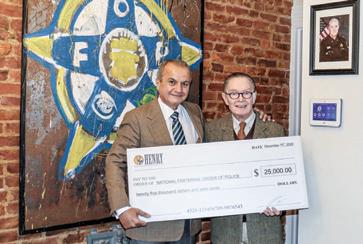
“This past year was the 25th anniversary of the Henry Repeating Arms Company and we set out this silver anniversary with a goal to donate $1 million in one year,” states Dan Clayton-Luce, Henry’s vice president of communications. “We accomplished this and more, making the ‘million dollar pledge’ a top priority.”
The future of the company is very bright and Clayton-Luce was excited to talk about the new line of revolvers Henry is coming out with. These wheel guns will complement the Henry lever-actions as a way to “tame the West,” with the Henry Big Boy Revolver and Big Boy Lever Action both being chambered in .357 so a shooter only has to carry one caliber of

ammunition. It will also open up the options for companies and programs that use Henry firearms as their choice when it comes to fundraisers, retirement gifts or commemorative items. Henry can help any company or person come up with a logo-specific firearm; Clayton-Luce mentioned how he was just in Missoula at Rocky Mountain Elk Foundation headquarters to drop off yet another check for the organization’s fundraising programs to help elk and elk hunters.


was founded in Brooklyn, New York, by Louis Imperato and his son, Anthony Imperato. They aimed to fulfill a demand for high-quality, American-made firearms. Henry’s first rifle, the Henry H001, was an instant success, and the company quickly grew in popularity.
Today, Henry has manufacturing facilities in Wisconsin and New Jersey and produces a wide range of firearms – around 200 different models of rifles, shotguns, lever-action pistols and more. The company produces a broad range of lever-action rifles in both rimfire and centerfire calibers in a variety of finishes, including blued steel, hardened brass, color casehardened, and “All-Weather.”
The company’s flagship model is the Henry Golden Boy, a rimfire lever-action with the tagline “the gun that brings out the West in you.” Henry has sold over 1 million of its model H001 Classic Lever Action .22 rifle, which has become a staple of the firearms industry.
Some of Henry’s other popular models include rifles, shotguns and lever-action handguns, each with unique designs and features. Some of their most popular models include
 The gun it all began with, the Henry Classic Lever Action .22, of which more than 1 million have been sold. It can be loaded with up to 15 .22 Long Rifle cartridges or 21 .22 Shorts, making it great for plinking.
The gun it all began with, the Henry Classic Lever Action .22, of which more than 1 million have been sold. It can be loaded with up to 15 .22 Long Rifle cartridges or 21 .22 Shorts, making it great for plinking.
the Big Boy, Mare’s Leg and Golden Boy rifles, as well as the Lever Action Axe. The company also offers a variety of accessories, including scopes, slings and magazines. Resurrecting the original Henry rifle, today it is offered in .44-40 and .45 Colt in various finishes. The Henry Lever Action .410 bore is the only lever-action shotgun on the market.


The Henry Single Shot Shotgun is available in hardened brass or steel in 12-, 20- and .410 gauges. The Henry Single Shot Rifle is also available in hardened brass or steel in over 10 centerfire calibers.
Then there’s the Henry US Survival AR-7, an updated version of the US Air Force AR-7, a takedown .22 ideal for all outdoorsmen. All of the rifle’s components fit into the buttstock. The Henry Mini Bolt is the ideal beginner’s rifle, a stainless steel singleshot .22 that is also the official youth rifle of the USA Shooting Team. Henry Repeating Arms is the official firearms licensee of the Boy Scouts of America, and several Henry Boy Scout editions are available.
In addition, the company has a line of tribute rifles honoring many deserving constituencies, including those serving in the military, first responders and American farmers. The Henry Corporate Editions program allows companies to place their logo on a Henry rifle for employee retirements, dealer rewards and
corporate milestones.
“The future is all about building on the foundation laid so far,” Anthony Imperato said early last year in an interview commemorating his company’s 25th anniversary. “We have a strong message, a strong desire to be the best gun maker in the country, and a strong group of people to keep the wheels moving. It is exciting to think about the direction that we are heading.”
IN ITS MISSION statement emphasizing commitment to quality, innovation and responsibility, Henry also includes dedication to charity work. The company’s website states, “We believe that our success gives us a unique opportunity to give back to our community, our veterans, and our country.”
Henry has a long history of supporting charitable causes, with a focus on organizations that support veterans and their families. In recent years, the company has made significant donations to organizations such as the Special Operations Warrior Foundation, the National Rifle Association, and the USA Shooting team.
Guns for Great Causes raises money for various charities with a mission to make a positive impact on society
Henry’s new wheel guns, like the Big Boy Revolver (pictured), are meant in part to complement rifles such as the Big Boy Lever Action. Both are chambered in .357, so you only have to carry one caliber of ammunition.

through firearms-related fundraising events. It hosts auctions and other fundraising events to support various charitable organizations and has partnered to support organizations such as the NRA Foundation and the Special Operations Warrior Foundation. Henry has donated unique firearms for auction, with proceeds going to these organizations.
These donations have helped raise significant funds for these causes, making a positive impact in the community.
Henry has also donated to several veterans’ organizations, including the aforementioned Special Operations Warrior Foundation, the Veterans of Foreign Wars
Big Boy Brass .357 Mag/.38 Spl Side Gate Rifle. Golden Boy Silver .22 S/L/LR.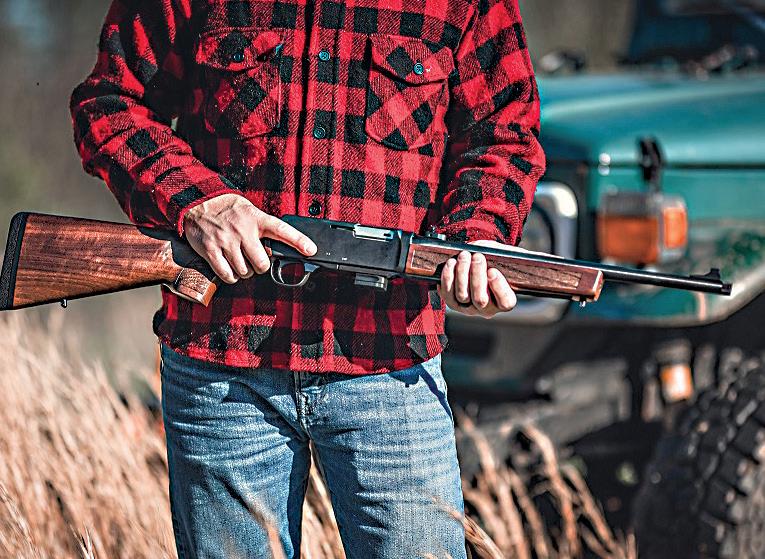





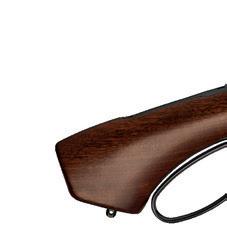





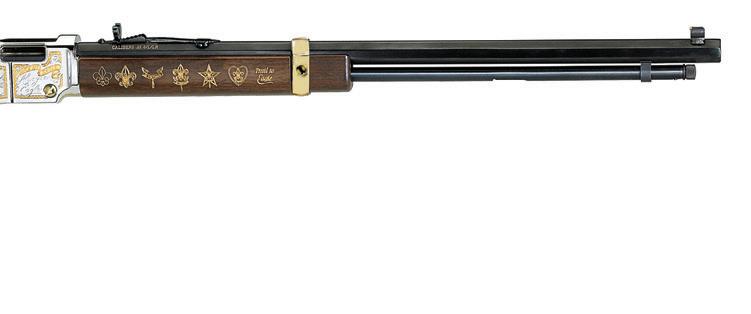

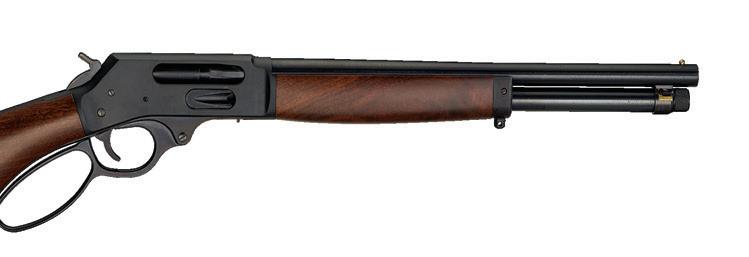 Lever Action .410 Shotgun Side Gate.
Single Shot Slug Barrel Shotgun.
Big Boy Mare’s Leg .45 Colt Side Gate Pistol.
Lever Action Axe .410 Bore.
Henry Big Boy Revolver. All-Weather .45-70.
Lever Action .410 Shotgun Side Gate.
Single Shot Slug Barrel Shotgun.
Big Boy Mare’s Leg .45 Colt Side Gate Pistol.
Lever Action Axe .410 Bore.
Henry Big Boy Revolver. All-Weather .45-70.
Foundation and the American Legion. These organizations help support veterans and their families by providing financial assistance, education and support services. Henry’s contributions allow these organizations to continue to make a difference in the lives of those who have served our country.
And Henry actively supports youth shooting programs across the United States; as of February 2022, it had donated “somewhere in the neighborhood of 10,000 guns” towards that end, according to Imperato. The company’s aim is to provide young people with the education and skills needed to safely handle firearms, while instilling a love and respect for the shooting
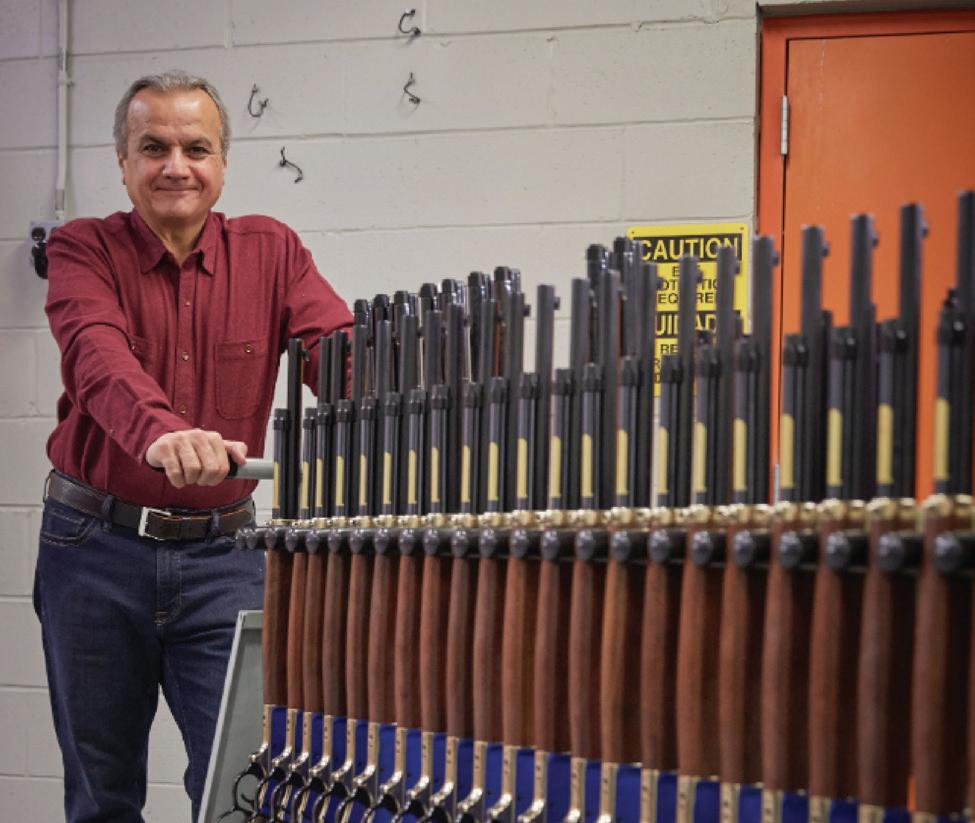
sports. The company supports the Youth Shooting Sports Alliance, the Scholastic Shooting Sports Foundation, and the Boy Scouts of America Shooting Sports Program. These programs offer training and competitive opportunities to young people interested in learning about firearms and shooting sports.
By supporting these youth shooting programs, Henry Firearms has helped to introduce young people to the world of shooting sports, potentially sparking a lifelong passion. They have also helped to promote safety and responsible handling of firearms, ensuring that future generations of shooters are educated and knowledgeable.
Indeed, over the years, Henry
Firearms has donated millions of dollars to various charitable organizations. In 2019 alone, they donated over $1.1 million to organizations such as the National Wild Turkey Federation and RMEF.
The impact of Henry’s giving can be seen in the many organizations and individuals they have supported. From youth shooting programs and Second Amendment causes to conservation organizations and veterans support services, Henry’s charity work continues to make a positive impact on the broader shooting community and beyond. Henry is always looking for new ways to give back and is open to exploring potential partnerships with organizations that align with its mission and values.



“Let us therefore animate and encourage each other, and show the whole world that a Freeman, contending for liberty on his own ground, is superior to any slavish mercenary on earth.” —George
Washington“Wherever the standard of freedom and independence has been or shall be unfurled, there will be America’s heart, her benedictions and her prayers be.”
—John Quincy Adams“America was not built on fear. America was built on courage, on imagination, and an unbeatable determination to do the job at hand.”
—Harry S. Truman
“Freedom makes a huge requirement of every human being. With freedom comes responsibility.”
—Eleanor Roosevelt
“All great change in America begins at the dinner table.”
—Ronald Reagan“My God! How little do my countrymen know what precious blessings they are in possession of, and which no other people on Earth enjoy!”
—Thomas Jefferson“Happily for America, happily, we trust, for the whole human race, they pursued a new and more noble course. They accomplished a revolution which has no parallel in the annals of human society.”
—James Madison“Where liberty dwells, there is my country.”
—Benjamin Franklin“Government of the people, by the people, for the people, shall not perish from the earth.”
—Abraham
Lincoln“In the truest sense, freedom cannot be bestowed; it must be achieved.”
—Franklin D. Roosevelt“Duty, honor, country. Those three hallowed words reverently dictate what you ought to be, what you can be, what you will be.”
—Douglas MacArthur


 STORY BY FRANK JARDIM
STORY BY FRANK JARDIM
Idon’t know if you can be a patriot and not get choked up a bit when you see Old Glory flying in the breeze. My thoughts go first to the sacrifices of our military forces, because without them, we could not protect and preserve our unique way of life from outside aggression.
The design of our flag represents

Before the familiar stars and stripes became official, our military forces went into battle under many unique flags. Perhaps the most famous of them is the one presented by Continental Colonel Christopher Gadsden to the fledgling US Navy’s commander-in-chief in December 1775. It was intended as a personal standard to be flown on the flagship. The coiled rattlesnake was by then a familiar element in the imagery of the American Revolution. Benjamin Franklin suggested the rattlesnake had many qualities in common with the new republic. Among them were lidless eyes that were always vigilant, and a peaceful nature unless provoked. The Don’t Tread on Me slogan has resonated with Americans since the Revolution. It appears repeatedly in our political history, and most recently, it was used symbolically by members of the TEA (Taxed Enough Already) Party.
our republic. The 13 stripes remind us of our nation’s birth, with the brave rebellion of the original 13 colonies from Great Britain.
A star represents each state in the blue field of the union that collectively make up the United States of America.
I ask you to ponder for a moment the significance of that. The collective talent and treasure of the 50 states,
working together in areas of common interest for their collective good, within the governing framework of our Constitution, allowed the United States of America to become the most productive and powerful nation on Earth by 1918.
Here are the stories behind a few of our great nation’s most famous flags.
The first official flag of the US may or may not have been made by Betsy Ross, a widowed Philadelphia upholsterer. The legend emerged around 1876 during the nation’s centennial, and was based on family oral history rather than hard facts. She did make flags for the new nation, as did many other upholsterers, tailors and seamstresses. Ross is known to have changed the design of the stars from six points to the more practical five-pointed stars, which are much easier to sew. Whether she and Colonel George Washington ever knew each other, much less collaborated on the first flag’s design has never been documented. Sometimes, history doesn’t let the facts get in the way of a good story, so to this day many believe Ross designed and made the first American flag. One thing is certain: This flag is the one that represented the new nation starting in 1777, through the majority of the Revolutionary War, and afterward, until 1795, when Vermont and Kentucky joined the union, increasing the number of stars to 15. It should be noted that not all flags of this period had their stars in a circular field. It was but one of many styles.

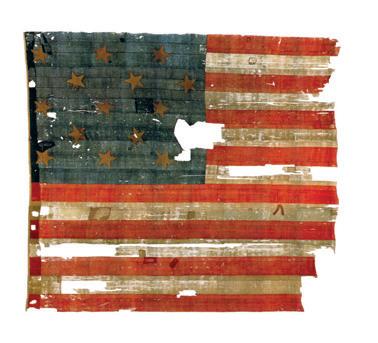


Currently on display in the Smithsonian Institution’s National Museum of American History in Washington, DC, this is the flag that flew over Fort McHenry during the Battle of Baltimore in the War of 1812. It inspired Francis Scott Key to write the poem that has since become our national anthem. This massive 30-inch by 42-inch garrison flag was made at the request of the fort commander, Major George Armistead, in preparation for the impending British attack on the city. Fort McHenry guarded the entrance to the harbor and stood in the way of the British. Major Armistead’s intent was that the British fleet should see the huge flag from a great distance as a matter of American national pride rather than tactical advantage. On September 12, 1814, the British launched an attack with 5,000 troops supported by cannon fire from a fleet of 19 warships. By the evening of September 13, intent on forcing their way into Baltimore’s inner harbor, the British began a 25-hour bombardment of the fort, but could not neutralize it nor compel the surrender of the defenders. Unable to seize the harbor, the British broke off their attack and withdrew. The proportions of this flag seem a little peculiar, because, in addition to its 15 stars, it has 15 stripes. The extra stars and stripes represented Kentucky and Vermont’s entrance into the young republic.
During the Battle of Little Big Horn in the southeastern Montana Territory, on June 25, 1876, a 263-man force from the 7th Cavalry Regiment, led by Lieutenant Colonel George Armstrong Custer, attacked a Lakota Sioux, Northern Cheyenne, and Arapaho village. When Custer learned the tribes had discovered his force, he feared they would disperse and escape, so he ordered an immediate attack. He grossly underestimated the size of the tribal force, which outnumbered him four to one. The Indians had many repeating rifles, while the cavalrymen had only the standard single-shot 1873 Springfield Carbine. The result was an epic defeat, resulting in the death of Custer and his entire force. Tattered, bloody and bullet-riddled, this flag was discovered under the body of a fallen cavalryman by a burial detail three days after the battle. The flag is swallow-tailed to reduce wind drag and make it easier for a mounted man to carry. It measures a compact 27½ inches by 33 inches. It sold at Sotheby’s auction in 2010 for $2.2 million to a private collector.




The second flag raised on the top of Mount Suribachi on the island of Iwo Jima by five US Marines and one US Navy corpsman on February 23, 1945, became the most famous American flag of World War II, when photographer Joe Rosenthal captured this image with his Speed Graphic camera. Before the 35-day battle to capture the island was over, half of the men in his image were dead. The total American casualties were 6,821 dead and 19,217 wounded. Of the 22,060 Japanese defenders, 18,844 were killed. Only 219 were captured during the battle. An astonishing 3,000 of the enemy retreated into the island’s elaborate cave system to commit suicide or hide in fear from the US forces, who they were led to believe were a barbaric enemy. The last holdouts didn’t surrender until 1949, four years after the war ended. This flag is on display at the USMC Museum in Virginia.




Despite being fortunate enough to hunt various game species around the world, I still look forward to the New York deer and bear season each fall; getting together with good friends and heading to familiar territory has a grounding effect. Each year I choose a rifle, prepare

a load for it and enjoy the buildup to the season opener.
In 2021, the Hudson Valley of New York – where I do a good part of my hunting – was hit with a severe bout of EHD, or epizootic hemorrhagic disease, claiming over 75 percent of the deer population along the river itself. The Catskill and Berkshire Mountains, which lie to the west and east of the Hudson, respectively, weren’t affected nearly as badly, but the valley was
hammered. It wasn’t as bad during 2022, and it seemed as though deer had moved in from surrounding areas, yet it didn’t take long to see that the numbers were still off.
For the 2022 deer/bear season, I had reached for my handy Browning X-Bolt rifle, chambered in 6.8 Western, and loaded it up with a monometal projectile from a relatively unknown company: Badlands Precision. Hailing from Yankton, South Dakota, Badlands

‘are equally accurate and terminally effective.’
Precision is the brainchild of George Fournier, and his bullets are rather terrific. Grabbing a set of reliable Redding dies and a couple types of (the now discontinued) IMR Enduron powders, I cobbled together some test loads. I put the 140-grain .277-inchdiameter Super Bulldozer 2 on paper a number of times during load development, settled on a load using IMR 4955 – which printed three-shot groups under ½-MOA – and was totally confident for the season.
Imagine my surprise when, on a rainy afternoon in early December as the season was winding down, a decent buck stepped out of the overgrown orchard, sniffing wildly for the scent trail of a hot doe that I hadn’t seen, but he definitely smelled. Settling the Leupold’s crosshair just behind the shoulder crease, I broke the Browning’s trigger, and heard the bullet hit. That buck didn’t go 25 yards, piling up in a thicket after doing that dead-anddoesn’t-know-it spin routine. Needless to say, with the impact of EHD, I was very happy to have taken the buck.
Here in the Northeast, the shot distances aren’t long; I took that buck at 90 yards or so. This probably didn’t show the full feature set of Badlands’ sleek projectiles, but it did speak to the construction. The bullet was recovered in a hindquarter, having penetrated over 3 feet of deer, and

weighed 114 grains. The high-impact velocity caused the front of the bullet to expand and then wipe off, giving no resultant expansion, yet the vitals were absolutely destroyed. I’ll take that kind of performance any day.
THE BADLANDS PRECISION Super Bulldozer and Super Bulldozer 2 component projectiles – yes, you’ll have to load your own – are monometal, lead-free projectiles with a boattail and an aluminum tip; the transition from tip to ogive is virtually seamless. The entire line of projectiles is designed for high ballistic coefficient, flat trajectory and – for the hunting bullets – excellent


The 140-grain bullet in .277-inch diameter is not a new idea, but in this configuration it will not stabilize in a conventional barrel; it requires a 1-in-8 twist. My Browning has a 1-in-7.5 twist, so there was no issue there. But like most monometal designs with a high BC, you may need to drop down in weight to get the bullet to stabilize in a conventional barrel. To give an idea of the differences between the 140-grain .277-inch-diameter Super Bulldozer 2 and a conventional bullet of the same weight and diameter, like the Sierra GameKing HPBT, you’ll see the former measuring 1.56 inches long with a G1 BC of .650, and the latter measure 1.192 inches long with a G1 BC of .337. The Bulldozer 2 and Super Bulldozer 2 series are great choices for the hunter

who wants the ability to reach out, yet also needs a tough bullet in the event of a close-quarter shot.
Fournier keeps his tolerances very tight; I weighed varying models of
his Badlands projectiles, in different calibers and weights, and never came up with a variance of more than 0.1 grain. And, according to his testing, his projectiles will expand reliably at velocities as low as 1,680 feet per second for the Bulldozer 2 and a little bit lower for the Super Bulldozer 2, which has a thinner ogive. Considering the high BC values these bullets possess, they make great choices for those who hunt at longer ranges; I can see where a sheep hunter or someone in pursuit of Coues deer would reach for these in a heartbeat.
THE BULLDOZER 2 is a bit shorter and less sleek than the Super Bulldozer 2, and generally uses a bit lower weight. Still, it is wonderfully competitive for a hunting bullet, and can demonstrate


excellent accuracy. I loaded up a 140-grain Bulldozer 2 in the new 7mm PRC cartridge, and it would put three in a group measuring right around 5/8 inch at the 100-yard target board. I also stuffed the 195-grain Bulldozer 2 in my .300 Holland & Holland Magnum. That rifle likes long bullets best and was happy with the Badlands bullet, putting three in a ¾-inch group.
In a rifle that has a conventional twist-rate barrel, the Bulldozer 2 is the way to go, as the Super Bulldozer 2 projectiles are (with a couple exceptions) designed for faster-thannormal twist rates. And as the Super Bulldozer is slightly tougher than the “2” variant, it might make sense for the hunter who normally stays within 500 yards to opt for the original design, as it will probably be easier to seat the Super Bulldozer in a conventional magazine.
If you run a custom rifle, embracing a faster twist rate to take full advantage of the higher BC values, then the Super Bulldozer 2 line should warrant an audition on your reloading bench.


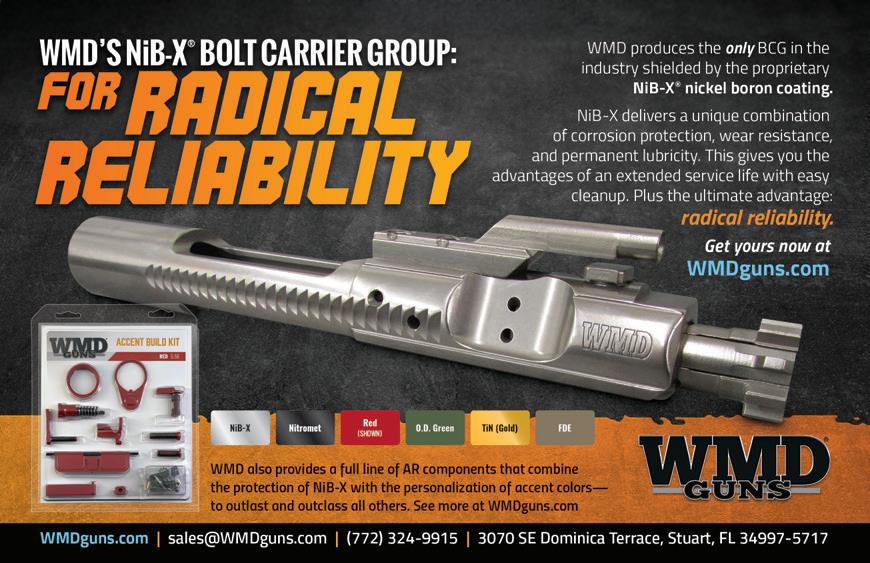

Considering that the 195-grain .30-caliber Super Bulldozer has a G1 BC of 0.675 (better even than the heavier Hornady 200-grain ELD-X with a G1 BC of 0.597, or the 212-grain ELD-X with a G1 BC of 0.663), and will stabilize in both my .300 Holland & Holland and .300 Winchester Magnum, there is an awful lot to be happy about in the Super Bulldozer line. And should


you want to run a faster twist, the 205-grain .30-caliber Super Bulldozer 2 (requiring a 1-in-8.5-twist barrel) will offer a G1 BC of 0.785.
Looking first at the 195-grain Super Bulldozer in a .300 Winchester Magnum, at a muzzle velocity of 2,925 fps with a 200-yard zero, you’ll see the bullet drop 6.4 inches at 300 yards, 18.4 inches at 400 yards and 36.4 inches
at 500 yards. At that 500-yard mark, the Super Bulldozer is still cruising at 2,270 fps, retaining 2,231 foot-pounds of energy and drifting 12.3 inches in a 10 mph crosswind. Switch to the 205-grain Super Bulldozer 2 at 2,850 fps, and you’ll see a slight advantage to 500 yards – as in slightly more retained velocity and a couple inches less wind drift – but it will need to be used out past 800 yards to see a real difference. Either bullet would be a fantastic choice for a sheep or elk hunter who routinely operates at longer ranges. Bottom line is this: Badlands Precision offers a pair of most excellent hunting bullets that are equally accurate and terminally effective. If you enjoy

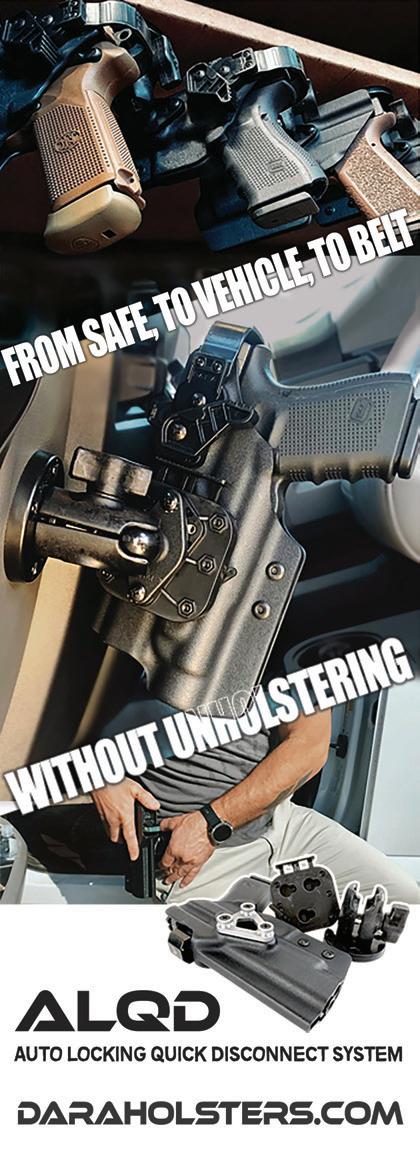

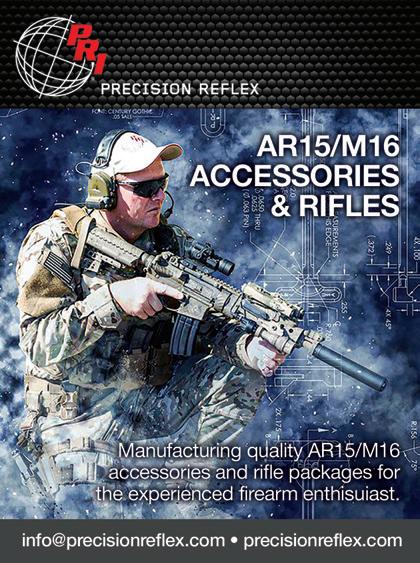
a boutique bullet experience, give George Fournier a chance, and order a box of Super Bulldozers for your rifle.
The Super Bulldozer line is available in .224 caliber at 55 and 62 grains; 6mm caliber at 80 grains; .257 caliber at 95 grains; 6.5mm caliber at 125 grains; .277 caliber at 128 grains; 7mm caliber at 140 and 150 grains; .30 caliber at 150, 175 and 195 grains; .338 caliber at 225 and 250 grains; and .375 caliber at 275 and 300 grains. The Super Bulldozer 2 line is available in .224 caliber at 70 grains; 6mm caliber at 100 grains; .257 caliber at 110 grains; 6.5mm caliber at 135 grains; .277 caliber at 140 and 150 grains; 7mm caliber at 160 grains; .30 caliber at 205 grains; .338 caliber at 250 and 275 grains; and .375 caliber at 365 and 390 grains.
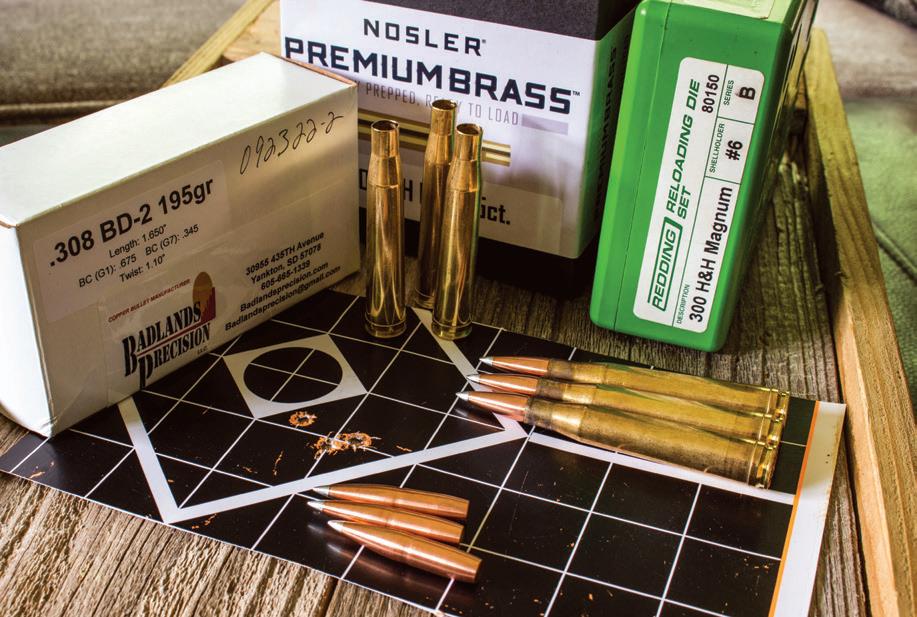
You can order the projectiles directly from Badlands Precision at badlandsprecision.com.


 The majority of dove hunts across the country take place in agricultural fields. On this Texas hunt, motorized dove decoys were used to pull birds within shooting range.
The majority of dove hunts across the country take place in agricultural fields. On this Texas hunt, motorized dove decoys were used to pull birds within shooting range.
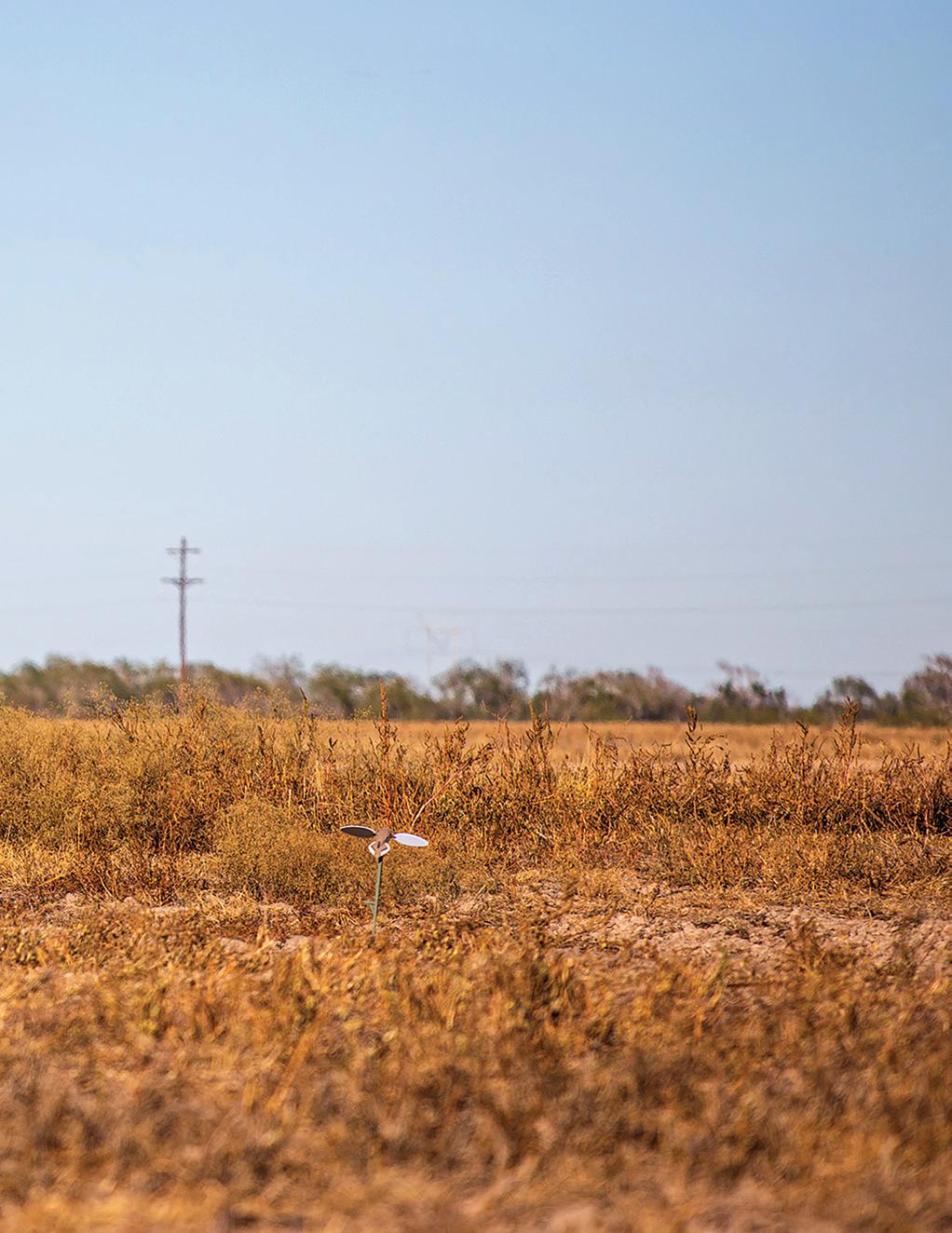
What was your first hunt?
For many of us, I bet the answer is doves. It’s the first hunt of fall, often starting before school kicks off, and comes at a time after a birthday ushered us into the realm of legal hunting age, when we waited and waited for a season –any season – to open. But today, look at us. Many of us are
focused on big game. Heck, a number of us have chased some of the most coveted critters on the planet. But our passion for the hunt began with doves.
While much of what I’ve written in this column over the past decade – yes, this marks 10 years of writing Road Hunter – has centered on big game, I want to step back to where it all began. Doves. Taking it a step further, let’s look at dove hunting and how you and your dog can start preparing for it now.
FOR YOUTH HUNTERS across the nation, dove hunting is a highly anticipated time. For those hunters with new gun dogs, the dove is the perfect bird to learn field discipline and build a range of skills on. In fact, doves were the first birds both of my pudelpointers hunted. Kona’s hunt took place in a field at 3 months old, while Echo’s first dove hunt – at 7 months of age – was in rolling hills with a pond nearby. Echo is now 9 years old and Kona is 7,

and both dogs have been on numerous dove hunts.
Dove season can be a great time to begin your pup’s hunting career, even if they’re young. Dove hunting days are typically warm and you don’t have to get an early start. But face it, it’s the amount of shooting action that attracts many of us to dove hunting, usually with a lot more misses than hits.

The majority of dove hunting across North America takes place in agricultural fields, where doves congregate to feed. Mornings, late afternoons and early evenings are prime times to hunt fields, as that’s when doves are feeding. Hunters set up along an edge, waiting for doves to either leave or enter the field. Setting up in the shade with the sun at your back will help keep your dog cool and allow them to spot birds – something that’s tough
to do when looking into the sun for approaching, fast-flying gray bombers. Be patient, especially with pups, as you want all interaction to be positive. Position your pup for success.
Dove decoys can be effective at helping to bring birds into shooting range. In states that allow motorized decoys, the added motion can yield impressive results because the moving wings catch the attention of doves from a distance. Then again, as in waterfowl hunting, there are times when doves want to be in a certain spot and nowhere else, meaning you may have to adjust your position to get into their flight path and hunt the X.
Before hunting a field with your dog, check for grass seeds. Some fields that are too thick with seeds may not be worth hunting, as they could be a danger to your dog. You don’t want
seeds embedding in their feet, ears, eyes or mouth. If it’s extremely hot, you may want to shave your dog’s coat, if it’s a long-haired pup. This not only helps keep them cool, but it also results in less grass seeds getting tangled in their hair.
Before dove season, pluck the long hairs from inside your dog’s ears. This long hair often traps dangerous seeds, which funnel into the ear canal. Removing most of the hair from inside the ear will help prevent seeds from getting trapped.
If setting up to hunt doves along fencerows, scour the area for loose barbed wire that a dog might tangle with. Don’t cut your dog loose to freely roam unless you know what’s out there.
Dove hunting over water is another effective approach. Where I live in the Pacific Northwest, many dove hunters
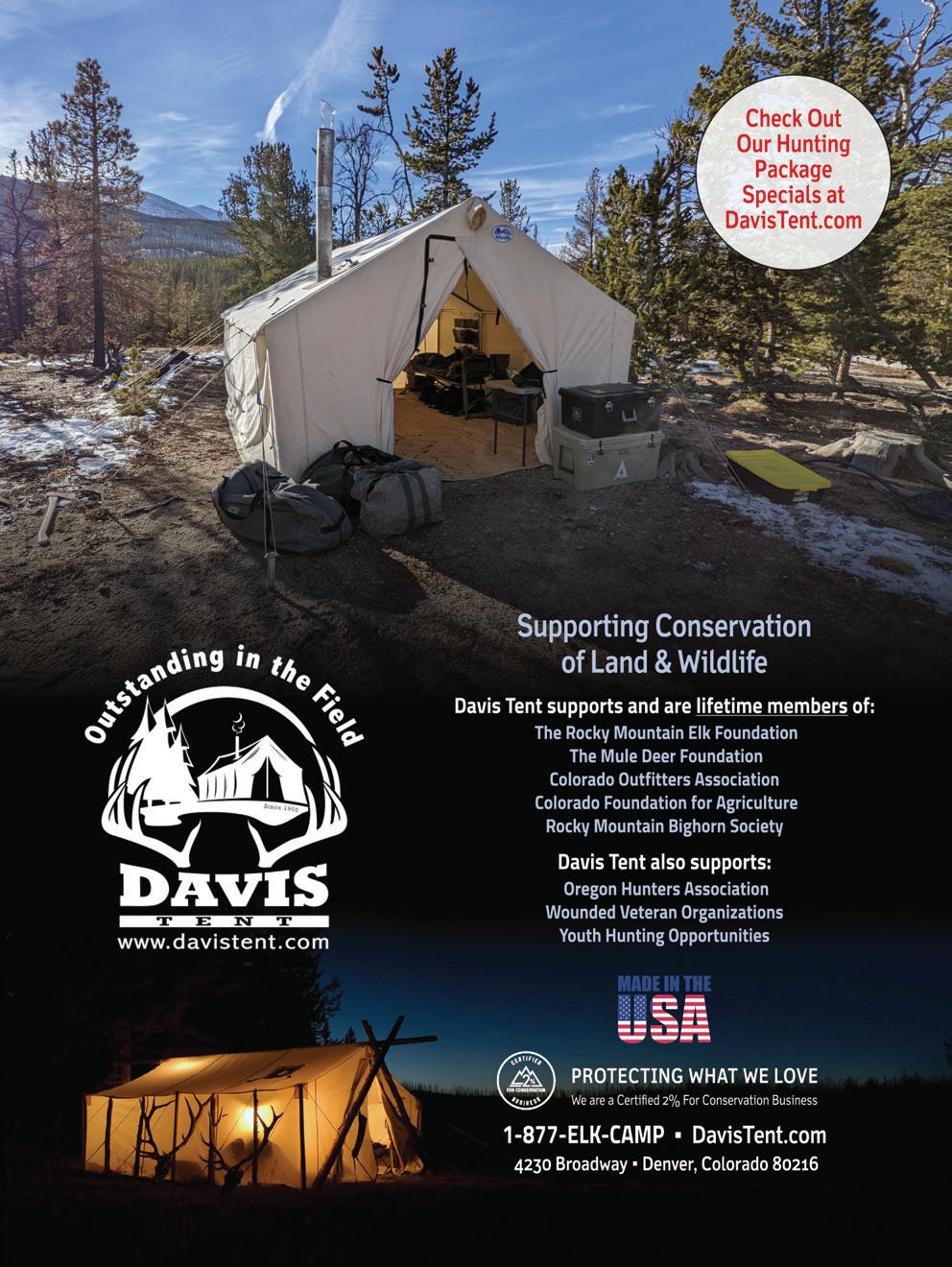
head to big rivers with exposed gravel bars. Doves not only frequent these habitats to drink, but they’ll also gather grit and roost in nearby trees. Evening hunts along rivers can be exceptional, and dogs always love playing in the water this time of year. It’s also a great opportunity to work on water entry and retrieves.

DOVE HUNTING IS fun, easy and inexpensive, and can be exciting for you and your dog. Enter the hunt with
patience and the goal of making it enjoyable for everyone – especially youth who may be involved – and you will come away having learned something while enjoying your time afield.
You won’t need much dog gear for a dove hunt, but a fine-toothed brush to remove burrs and a protective dog vest can be helpful should seeds be an issue. I like hunting short grass fields where seeds aren’t a concern and where it’s easier for dogs, especially pups, to mark birds. Set your dog up for success, just
as you would when training.
If it’s exceptionally hot, have enough water to cool your dog down by pouring and rubbing it on their belly and behind their ears. Aging or overweight dogs can easily overheat and suffer from hyperthermia on earlyseason dove hunts. Hyperthermia can be life-threatening and is actually more common than cold-weather hypothermia. Dark-coated dogs should always hunt from the shade on hot, sunny days. Have plenty of water for

you and your dog to drink, too, and closely monitor their demeanor. A driven hunting dog will push itself to death; it’s up to you to make sure that doesn’t happen.
Because there are so many shot opportunities when dove hunting, don’t be in a rush. You want to maintain control of your dog and keep them focused at all times. Pups will especially benefit from calm direction, eye contact and walking them through basic hunting expectations. If wearing shooting glasses, use a pair with clear lenses so your dog can see your eyes. Dogs learn a lot and try to predict your next move by reading your eyes.
Veteran dogs can also benefit from dove hunting, especially through high-volume shoots, long-distance retrieves and other advanced handling objectives. If you have something to work on before upland bird and waterfowl season, this is a great opportunity to hone those skills with your dog. Have fun, communicate your expectations and hunt with a purpose. Doing this will help you and your dog.
Doves have very loose, dry feathers, so thoroughly clean your dog’s mouth following each retrieve, even if there are multiple birds down. Dry mouths can lead to discomfort, overheating and a reluctance of your dog to continue working. This is where having plenty of water helps.
When a dove is down and your dog is searching for it, refrain from firing over its head, as this will result in hearing loss. Be sure to keep track of where your dog is in the field when lowflying doves whiz by. When it comes to doves, you don’t have to force the shot, as there will be more opportunities.
FIELD LOADS, EVEN trap loads, are effective for dove hunting. I like 2¾inch No. 7½ shot when hunting fields and over water, and No. 6 shot when hunting hill habitat for doves. Be sure to check the local regulations in case there are any nontoxic shot requirements for the area you plan to hunt. This is becoming more common


across the country, so know the regulations prior to hunting.

If you have a pup that’s new to hunting and appears gun-shy, try hunting with a smaller-gauge shotgun like a .410 or 20-gauge. If gun work with your pup is a top priority of the hunt, have another hunter join you so they can shoot and you can focus on handling your dog. You want your pup’s first hunt to go smoothly, and often that means focusing your attention on it, not pulling the trigger.

Dove hunting builds shooting skills. Birds are plentiful, often coming in from all angles, which allows you to
swing from both the left and right, as well as shoot approaching birds and those passing straight overhead. Doves are also small and dart around quickly, making them challenging to hit and difficult for dogs to mark. A pup will likely need help retrieving doves at first, so get a mark on the bird so you can position your dog to work into the wind and have a successful retrieve. There aren’t many hunts where we can sit and actually wait for birds to pass in front of us for a shot. With this style of hunting comes a great opportunity to teach your pup steadiness and proper obedience while
on an actual hunt.
Recall all the training drills you’ve done, and will be doing, this summer and how you’re preparing your dog for the upcoming bird season. Then think of continuing that training by way of a hunt – in this case, for doves. That’s what dove hunting is all about: having fun and creating lots of opportunities that will make you and your dog better hunters.
Editor’s note: For signed copies of Scott Haugen’s bestselling books, visit scotthaugen.com. Follow Scott’s adventures on Instagram and Facebook.


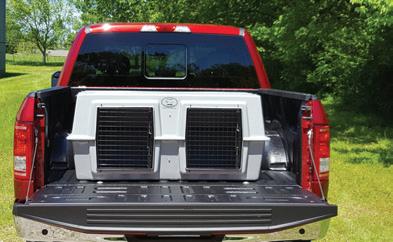




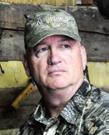
 STORY BY LARRY CASE
STORY BY LARRY CASE
“Uneasy lies the head that wears a crown.” –William Shakespeare
Just to be blunt about it, when I entered the gun writer world several years ago, I had no idea what I was getting into. I have enjoyed talking about firearms and the many related issues, meeting
the wonderful people I have come in contact with in the gun and outdoor industry (most of them), and – don’t tell anyone – I have learned a lot about guns since I started down this writing trail. I came into this
knowing a good bit about guns, having been around them since I was a little kid. I was a faithful acolyte of Jack O’Connor, Warren Page, Townsend Whelen, Elmer Keith and others at a tender age. I had a lengthy career in law enforcement and took every course offered to become an instructor for rifle, pistol and shotgun, as well as an
armorer for a couple different guns. But even with all this, I never thought I was a fount of knowledge on every firearm ever made.
I think many people expect the guy who has an article in a gun magazine or website to be an absolute expert on firearms – all types of firearms. So I might as well go ahead and say it: I never portrayed myself as an expert on every type of firearm ever made. I don’t believe anyone can be – there, I said it – although some gun writers will no doubt think otherwise. (There is a rumor in the gun industry that some gun writers have a slight ego problem.)
I happen to like shotguns and know a little bit about them, which I am very happy to share with you here in American Shooting Journal. As you might imagine, when you write articles for different magazines, you get questions on shotguns and other
firearms. Here is a sample of some of the most frequent.
DEAR SHOTGUN GUY, I want to buy a pumpaction shotgun for hunting ducks, turkeys and small game, as well as shooting a few clays. I am looking at the Mossberg 500 and the Remington 870. Which one is best?
This is the most asked question in the “which shotgun is best” realm. First, hear me out about the whole concept of which one is “best.” We seem to live in a time when many folks want to get on social media or gun-related forums and get instant answers. First, remember that most everyone on the internet is an expert and is eager to tell you all they know. Next, I think often there is no real best for anything, whether it be a hunting knife, hunting dog, four-wheeldrive vehicle or a shotgun. Different shotguns fit different applications, so
determine what this gun will be used for, find a few models in this area, and compare them to see which one suits you best.
The Remington 870 is the most popular shotgun ever sold (north of 11 million) and has served generations of hunters and shooters well. I’ve heard all the complaints about a certain era of the 870 Express models having various faults. I currently own at least three different vintages of the Express models and I can’t find much wrong with any of them. I wouldn’t be afraid to go into a used gun shop and buy most any 870 you find, Express model or a Wingmaster.
RemArms (remarms.com), the company that is now making Remington firearms, has been producing a new version of the 870 called the Fieldmaster. It is a solid 870 shotgun with nice walnut furniture, a

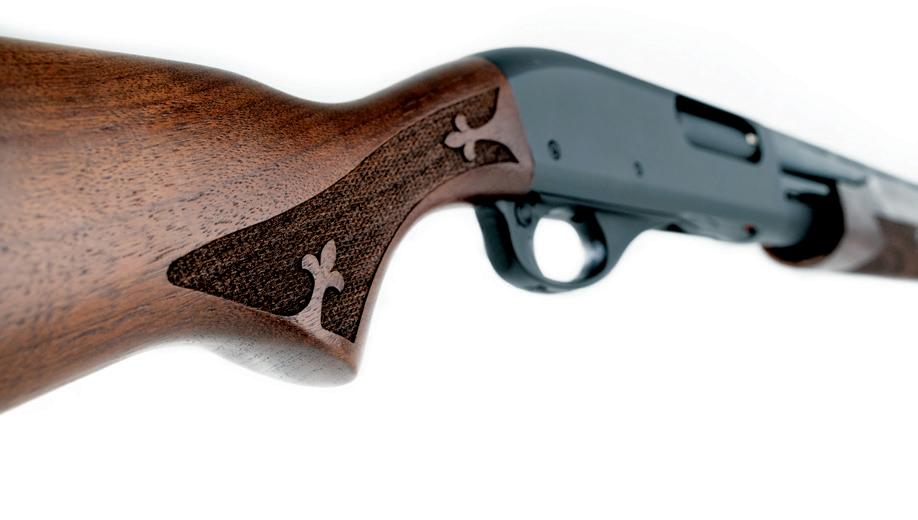

durable matte finish (much better than the old Express models) and a beefedup set of action bars. If I wanted a new 870, I would buy a Fieldmaster today.
The Mossberg 500 shotgun – and its many variants – probably only slightly trails the 870 in terms of sales. The 500 series from Mossberg (mossberg.com)
has served a couple generations well and has a very loyal following. The 500 is rugged, built like a tank and will go bang every time you yank the trigger. One big advantage I will always give Mossberg is the location of the safety on their shotguns: under your thumb on the back of the receiver. This makes
it ambidextrous and right where a safety should be.
Is one of these shotguns “better” than the other? No, they are both very serviceable pump shotguns. Just as with the old Ford or Chevy issue, it is the one that suits you best.
DEAR SHOTGUN GUY, I just inherited my grandad’s Browning A5 12-gauge shotgun. Is this a good shotgun? Can I still shoot this gun and hunt with it? What is it worth?

Wow, where do I begin? The Browning Automatic 5 shotgun, usually known as the Auto 5 or A5, is one of the many inventions of firearms genius John Moses Browning and was the first mass-produced semiautomatic shotgun. Browning first tried to sell this patent to Remington and Winchester, but when they turned him down, he got on the boat and went to Fabrique Nationale Herstal (FN) of Belgium. (This is where the term “Belgium Browning” comes from for the guns made in that era). Browning later licensed Remington to make this gun and they produced the Model 11; Browning also licensed Savage, which produced the Model 720 and later the 725.
The Remington and Savage guns were very similar to the FN guns. The Auto 5 is a recoil-operated shotgun and John Browning’s design for this action was later adopted to the Remington 1148 and the Franchi 48L. With its sharp cutoff on the back, the shape of the receiver on the A5 is very distinctive, giving it the nickname “humpback.” Many shooters (like me) believe this configuration is very beneficial in that it quickly gets the shooter’s eye on the gun and aligned down the rib or barrel of the shotgun.
Pricing any older shotgun can be tricky and maybe even more so with the A5. This shotgun went through several stages in its production; manufacturing started in Belgium with FN and when World War II started, production was moved to Remington in the states. After WWII, it was returned to Belgium, where it


stayed until the end of 1998; however, in 1975 much of the production began occurring in Japan. So what you have is several different eras of guns being made at different times in different places. All of these factors are variables in pricing any older A5, but the resources for pricing these guns on the internet are legion.

Telling someone that an older gun is OK to shoot can also be tricky; as always, if you have any doubts, take the gun to a qualified, experienced gunsmith (not your brother-in-law) and let them fully check it out. If this gun was mine and I wanted to hunt with it, I would do it in a heartbeat.

A5s were meant to hunt with and shoot. I guarantee your grandad didn’t think twice about it – just like what the weather was that day – if he wanted to go hunting. I actually saw a question about this recently on one of the shotgun forums where an internet expert told an A5 owner not to take it waterfowl hunting. Go figure; the A5 may have been the most popular shotgun for duck hunters in its day. Browning (browning.com) is making a modern version of the A5, and while this shotgun resembles the older model, internally it has few similarities. That is OK, however, as the new Browning A5s that I’ve shot
have performed well. You may want to check out the new versions of the A5, including some of the Wicked Wing models for waterfowl hunting.
Editor’s note: Larry Case has been a devoted outdoorsman since he was a child. He will admit to an addiction to turkey hunting (spring and fall), but refuses any treatment. He enjoys the company of gobblers and cur dogs that are loud and people who speak the truth softly. Case served 36 years as a game warden in West Virginia and retired with the rank of district captain. You can check out his podcast and other stories at gunsandcornbred.com.


Tap Rack Holsters is a leading provider of premium American-made gun holsters and knife sheaths. Our products are the result of 40 plus years of combined experience in the military and law enforcement field using American made materials. Every Tap Rack holster and sheath is handcrafted using extreme care, precision and built to last because we’re dedicated to providing premium quality products our customers can rely on.

a PREMIUM QUALITY
a FULLY FUNCTIONAL
a LIFETIME WARRANTY
a CUSTOM BUILDS
a BUILT FOR EXTREME USE
a MADE IN AMERICA
a BUILT WITH AMERICAN MATERIALS AND PARTS
a MADE BY AMERICANS AND VETERANS

Animals have long been used by the police. In the early days of American law enforcement, US Marshals, local sheriffs and others used horses as a means of conveyance, chasing down fugitives. They’re still used today for crowd control and ceremonial purposes.
But the dog is, by far, the animal most often associated with cops. Dogs with a great sense of smell can sniff out contraband at airports, during traffic stops and at our nation’s borders. Canines are often tasked with searching residences and businesses for burglars.
Dogs are trained to sniff out all sorts of things, from cadaver dogs used to search rubble of collapsed buildings, to canines trained to sniff out explosives and firearms. I recently worked with a dog trained to locate hidden electronics – items concealed by those who produce and distribute child pornography.
As an aside, I appreciate the work these dogs do, but I’m not always a fan of using them in dangerous situations. Dogs are so loyal that they will blindly sacrifice their lives to protect others. As a dog lover, it saddens me to see one lose its life in an operation. Unfortunately, that is an unintended result of putting them in harm’s way to protect their handlers and others. (I’m married to a former law enforcement canine handler, so I know how a work dog can become a member of the family.)
THE SHERIFF’S OFFICE in Kane County, Illinois, uses canines to keep its jurisdiction safe. On May 24 of this year, Hudson, a 4-year-old Dutch shepherd, was on routine patrol with handler Detective Luke Weston. They responded to the scene of a carjacking involving a suspect with a handgun.
Deputies were pursuing the stolen vehicle through county streets, when the suspect abruptly exited the vehicle, armed with the handgun, and prepared to fire at officers. That’s when Detective Weston deployed Hudson.


Hudson quickly launched itself at the suspect, latching onto his arm. The suspect fired at officers and, in the exchange, Hudson was hit. The suspect was killed.
Unfortunately, so was Hudson. Prior to passing away, though, the shepherd crawled back towards Detective Weston. Hudson’s last actions were to protect him.
The violent affair was over and, due largely to Hudson’s actions, there were no victims or officers hurt.
On June 1, Hudson – named for an
Illinois state trooper who had also been killed in the line of duty – was laid to rest. Hundreds of people, along with a large contingent of four-legged law enforcers, packed a school gymnasium to pay their respects. Hudson had spent three years as a member of the sheriff’s office, responding to hundreds of calls. Specializing in narcotics and patrol, Hudson helped in the seizure of over 100 kilograms of illegal drugs and tracked down more than 100 criminal suspects and missing persons.
Crossing over the Rainbow Bridge, Hudson left a better, safer world behind.
Editor’s note: Author Nick Perna is a sergeant with the Redwood City Police Department in northern California. He previously served as a paratrooper in the US Army and is a veteran of Operation Iraqi Freedom. He also has a master’s degree from the University of San Francisco. He is a frequent contributor to multiple print and online forums on topics related to law enforcement, firearms, tactics and veterans issues.

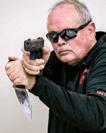
 STORY BY PAUL PAWELA
STORY BY PAUL PAWELA
Two developments precipitated the writing of this article. First, in my home state of Florida, our great governor Ron DeSantis signed a bill making Florida a constitutional carry state, which means a citizen of Florida is not required to be licensed to carry a firearm. Second, the number of violent acts in the United States is
epidemic. It now involves young people from the ages of 9 to 25 committing the most heinous and violent crimes that are on the books: drive-by shooting, rape, robbery, murder, kidnapping and carjacking, to mention a few. And it is not just young males committing these crimes; we are seeing an increasing number of young women committing acts of violence as well.
Back to the number one reason for writing this article: many people who own a gun for their protection do zero
training (shooting at paper targets is not training) for such a deadly force encounter. As the Navy SEAL saying goes, “Under pressure, you don’t rise to the occasion, you sink to the level of your training.” All good firearms instructors worth their salt will agree.
Training cannot be emphasized enough because if you want to reduce your risk and manage your fears, you train. The most successful people who do this well are tactical police officers, highly skilled gangsters and highly
trained people, period!
So, the question is, if you are an armed citizen, do you have the skill set to take on highly trained bad guys? Moreover, do you have the mindset to engage a young juvenile with deadly force? Do you have it in you to pull the trigger on a woman – who may even be pregnant – that is threatening your life or your loved ones? Are you positive that not only do you have the training to negotiate that scenario, but you have the intestinal fortitude to pull this off as well?
Using armed robbers and murderers Bonnie Parker and Clyde Barrow as a case study, we’ll look at the lessons learned from both the criminal side, as well as that of the lawman who tracked them down, Frank Hamer. We’ll also look at their common denominators.
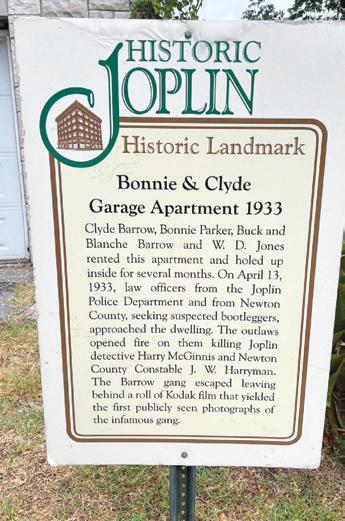



IN MY SELF-DEFENSE training sessions, I make the analogy that in a deadly force encounter, you are either part of the crime scene or you are the crime scene. The example I give is this: You are inside
a bank when, all of a sudden, Bonnie and Clyde’s gang comes in with guns drawn – shotguns or assault rifles, or both – and commands, “This is a bank robbery! No one moves and no one gets hurt!” You have a split second to decide what you are going to do. Should you survive that encounter, you will be interviewed by local, state and federal officers as to who, what, when, where and why everything happened. In other words, you are every bit a part of that crime scene.
Now let’s say you’re at the ATM at

your bank, and once again, the Barrow Gang advances toward you, guns drawn, and commands you to give up the money you just withdrew. Once again, your split-second decision will determine your fate, and once again, you become the crime scene.
I use the Bonnie and Clyde gangsters as a reference because, as a couple, they shot to notoriety in the era of America’s “first” Great Depression, from 1929 to 1939, caused by a significant fall in stock prices on Wall Street that crashed the market. Since times were challenging and jobs scarce, many people turned to the “easy” hard path of becoming criminals, and eventually, gangsters.

In addition to Bonnie and Clyde, the careers of infamous gangsters such as John Dillinger, Charles “Pretty Boy” Floyd, Al Capone and George “Machine Gun Kelly” Barnes were born during this time. They all did what criminals do: terrorize innocent people by robbing, kidnapping and murdering. Law enforcement personnel tried to apprehend them, sometimes with tragic results, as many sustained
lifelong injuries or were killed outright by the gangsters and their cronies.
Such was the case with Bonnie and Clyde. By the time they were tracked down and killed by law enforcement, Bonnie, age 24, and Clyde, 25, had 16 warrants for auto theft, carjacking,
robbery, assault and the murder of nine police officers and three civilians.
CLYDE BARROW’S LIFE of crime started in his teenage years (like today’s criminal element). What started as petty theft graduated to home burglaries, then to safecracking and automobile theft. At age 17, he was sentenced to years of incarceration for grand theft. He was ordered to a prison farm, where guards routinely beat and brutalized their prisoners by pistol-whipping, whipping or outright executing inmates. The incident would change Barrow forever; at 5 feet 6 inches and around 120 pounds, he was sexually assaulted repeatedly by a much larger inmate. It was so bad that the teenager took a metal pipe and beat his attacker to death. Barrow did not leave prison as a rehabilitated man; he left as an angry, hardened criminal who vowed never to be taken alive and returned to prison.
There are several lessons to be learned from Barrow and his gang, who were all repeat hardened criminal offenders that practiced their craft. For instance:
• Highly proficient with all weapons and believing in superior firepower, Barrow and his gang practiced regularly with pistols, revolvers, semiautomatics,
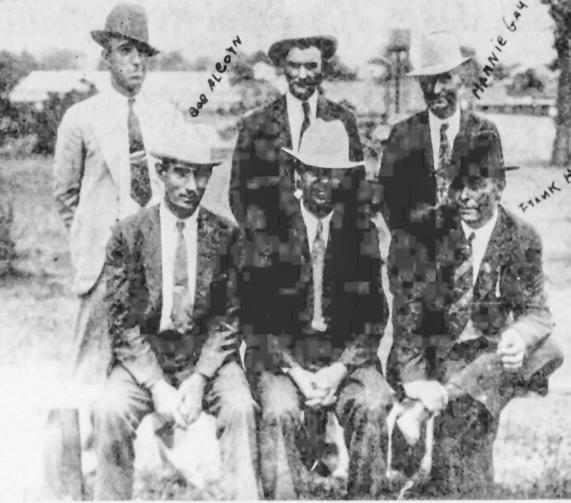
Made of durable steel construction - heavyduty, sealed ball bearing motors - thermally protected - fast, quiet operation - 3/4 to 4 3/4 gallon capacity - industrial and rotary models available. Send for our free brochure!
TRU-SQUARE METAL PRODUCTS, INC.


P.O. Box 585, Auburn, Washington 98071
TEL (253) 833-2310 or Toll Free 1-(800) 225-1017 www.thumlerstumbler.com
t-tumbler@thumlerstumbler.com
“Manufacturers of quality case cleaners, deburring and tumbling equipment since 1959”

shotguns and Browning automatic rifle machineguns. They would often modify guns to fit their needs. Barrow had a welder shorten the barrel length and weld three magazines together, giving him 60 rounds in .30 caliber. He taught Bonnie Parker, a 100-pound 4-foot, 10-inch woman – never underestimate your opponent by height, size, weight or sex – to be proficient with all weapons, including the Browning automatic rifle.
• In gunfights, Barrow stayed calm
and took charge, giving strong verbal commands, which everyone followed.
• Proficient in rendering self-aid and first aid, Barrow and all members were shot or injured many times before being killed. Not only did the gang members deal with extraordinary pain (mindset), but they treated each other’s wounds with primitive field dressings and other minor medicines they had on hand (heartset).

• They would kill without hesitation if
• Barrow had excellent driving skills. He chose the Ford V8 because it was the fastest model car of its day and could outrun police cars. It also had the best steel among cars made during that time, which aided in ramming other cars and stopping low-caliber bullets.
FRANK HAMER WAS hired to track down and help kill Bonnie and Clyde. He was noted as one of the greatest lawmen


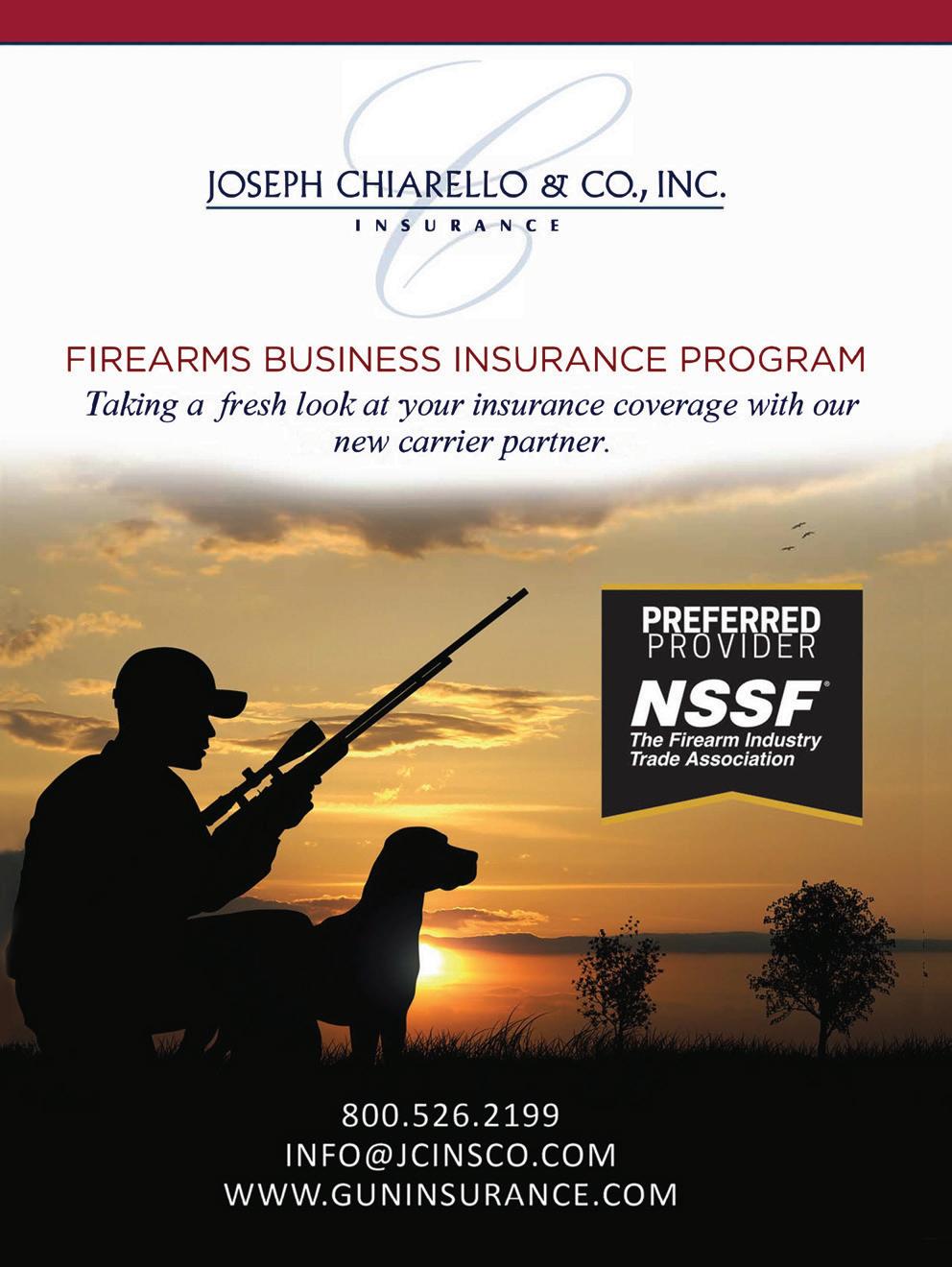
in the country’s history, with over four decades of experience with multiple departments. He was involved in over 50 gunfights, with more than 53 confirmed kills. Hamer was shot 17 times during his career and left to die four times.

An entire article needs to be devoted to this great man, and perhaps in the future we will do so, but for now, let’s look at what we can learn from Hamer.
• Religion greatly influenced Hamer’s life; Hamer had honor, courage,
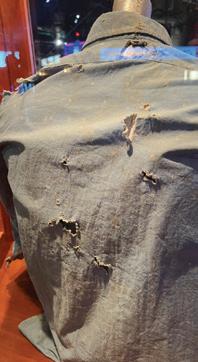
character, loyalty, respect for women, and a firm resolve to never back down from an enemy.
• Hamer took great pleasure in mastering self-reliance skills; he was a master of living in the outdoors and of hunting and fishing. He was a selfstudy on how Native Americans sought survival; he taught himself patience, endurance and independence.
• Hamer literally grew up living with guns. His marksmanship would become legendary, and he also would become a killer of bad men at an early age.

• The difference between Hamer shooting bad guys and Barrow shooting good guys was Hamer’s shooting style. He believed in calm, deliberate marksmanship, firing as few shots as possible, thus reducing the danger to innocent civilians.
• In Hamer’s pursuit of Bonnie and Clyde, he went after them with specific modified weapons. The rifle he used to kill Bonnie and Clyde was a modified Remington Model 8 with a 20-round magazine; his posse was armed with Model 8 rifles, a Browning
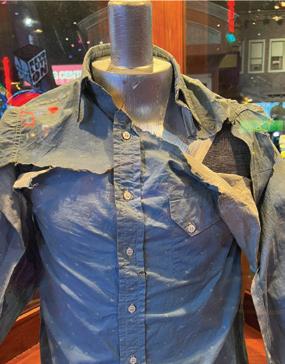


automatic rifle, semiautomatic shotguns, and handguns.
• In the ambush itself, the all-male ambush team had reservations about shooting a woman, but in the end, they did not hesitate in doing so. They unleashed over 100 rounds into the automobile Bonnie and Clyde were in; Bonnie was shot 26 times, and Clyde was hit 17 times (the first round to hit him in the head killed him instantly).
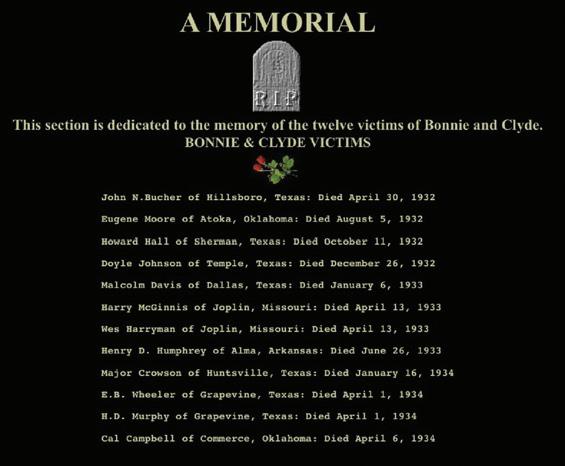
The question for you, the armed citizen, is how prepared are you to take on trained gangsters, male or female?
The answers to surviving are found in all the common denominators, good and bad. And that’s my two cents.
Editor’s notes: This story includes images by author Paul Pawela and that were drawn from the public domain. Pawela is a nationally recognized firearms and self-defense expert. For his realistic self-defense training, see assaultcountertactics.com.




UM Tactical is a leading firearms company that specializes in innovative firearm holsters, mounting systems, parts and magazine accessories. Founded in 2013, UM Tactical has quickly become a recognized name in the firearms industry and is known for its high-quality products and commitment to customer service. UM Tactical’s products are designed with patented technologies and innovative

designs, such as the RAGE TCS, or Rapid Adjustable Gas Expulsion
Total Compensation System, which revolutionizes traditional compensator designs. But it all started with one shooter’s need to mount a sight on a handgun.
IN 2012, BRIAN Wilson went to his garage and built a mounting system for his handgun. He was looking to put a sight on his firearm for an upcoming hog hunt and, being a craftsman by
trade, he took it upon himself to design the mounting system so no additional tooling would be needed to affix the sight on the handgun. In that garage he came up with what would become the UM3 sight mount and showed it to his wife Janet. The two of them realized that this sight mounting system was something that other shooters would be interested in.
It took a year to turn that first prototype sight mount into a business and in 2013 the Wilsons formed UM
Tactical, still manufacturing products in that same garage. After a few years of trials and tribulations, the small company made it out of the garage and became the formidable business that it is today.
“It started with the UM3 mount, which is completely universal and no tooling needed, and then Brian made a holster for it and that is what started our journey into the holster world,” explained Janet Wilson.
Patents and trademarks were acquired, but even then some other manufacturers started to copy their designs.
Like any other small mom-and-pop business, it took some learning of both the manufacturing and legal worlds, but the popularity of UM Tactical kept growing. Brian Wilson designed all of the machines that are used to make each of their products. Every holster is handmade one at a time in their Florida manufacturing plant.
Once the UM3 sight mount and holsters were becoming mainstream, UM Tactical teamed up with Taurus in 2018 and began a rebranding campaign. This led to the expansion of their holster line, including revolvers.

In addition to handgun accessories and holsters, Brian Wilson’s
background and machining expertise also led to the development of the RAGE TCS compensator. Deemed “the world’s first re-configurable recoil management system,” the RAGE TCS is a revolutionary concept that allows the user to switch between a muzzle brake and a compensator in a matter of seconds. This technology allows the user to customize the firearm to their specific needs, whether it be for accuracy or recoil reduction. Some of the advantages of the RAGE TCS include easy installation, reduction of felt recoil, no modifications needed in the tuning process, an allowance for extremely accurate follow-up shots, and more. The RAGE TCS also conforms to 3-Gun Nation and USPSA Multi-gun rules for competition shooters.


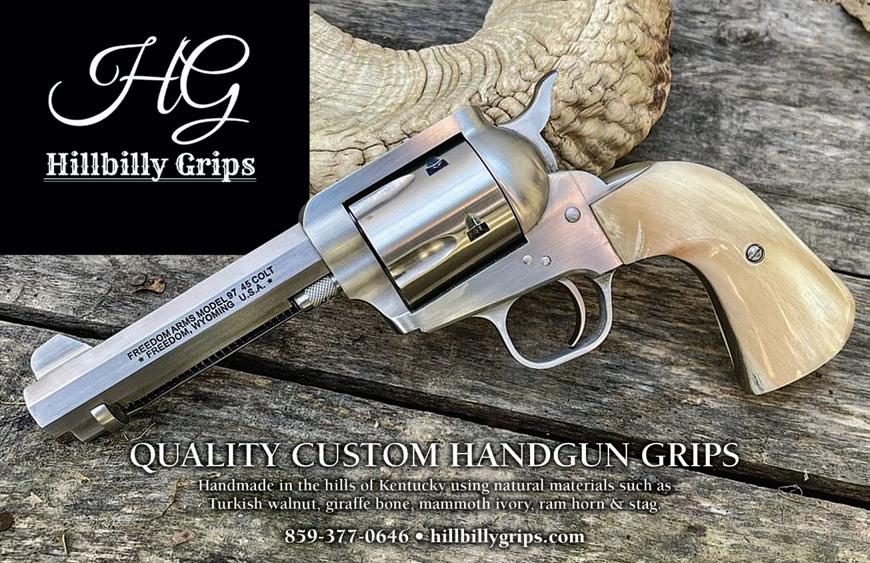
UM TACTICAL’S PRODUCTS are manufactured in the US using the highest quality materials and undergo rigorous quality-control standards. The company’s commitment to quality is evident in their products, which are built to last. UM Tactical also prides itself on its exceptional customer service and technical support; the team is knowledgeable and passionate about the products they sell and are always happy to assist customers with any questions or concerns they may have.
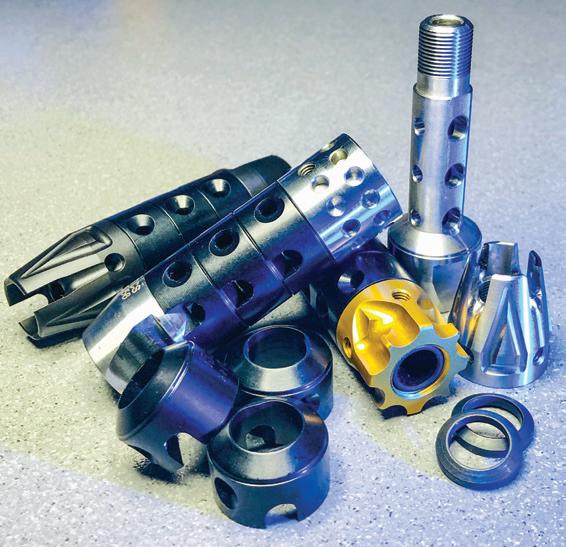

Looking beyond firearms products, UM Tactical gives back. When a hurricane hit the area, the company shut its doors for three weeks to help the local community. UM Tactical’s facility was not hit by the hurricane but several neighbors suffered damage, so the team went to work, clearing debris, helping rebuild and providing support for their friends, family and community members. This goes to show that UM Tactical is not a big-box store that only cares about
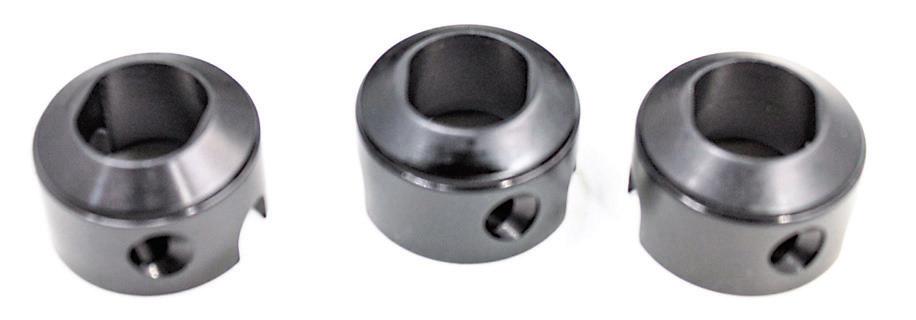


profit, but instead is a local Floridabased family company willing to help others, including its customers.
UM Tactical has also earned a reputation for producing quality gun accessories that are reliable and durable. Many customers have noted the quality of UM Tactical’s holsters, citing their comfort and fit. Some have also noted how easy the holsters are to draw from, which is critical in any emergency situation. The holsters are made from Boltaron, which is extremely strong and impact-resistant. Most other companies use Kydex, which is easily formable with heat and then pressformed. Boltaron is much stronger and holds its strength in extremely cold temperatures, which can cause other materials to become brittle.
Customers have reported using UM Tactical’s products in real-life situations, and the accessories have performed exceptionally well. The fast and easy draw of the company’s holsters has saved many lives in selfdefense situations.
UM Tactical is actively seeking ways to expand its reach while maintaining the quality and reliability of its products. The company plans to expand into new markets while continuing to focus on its core products. Part of the expansion process includes building a brandnew state-of-the-art 8,400-square-foot manufacturing and headquarters plant in southwest Florida. This will allow the company to make its current products as well as conduct research and development into future innovations.
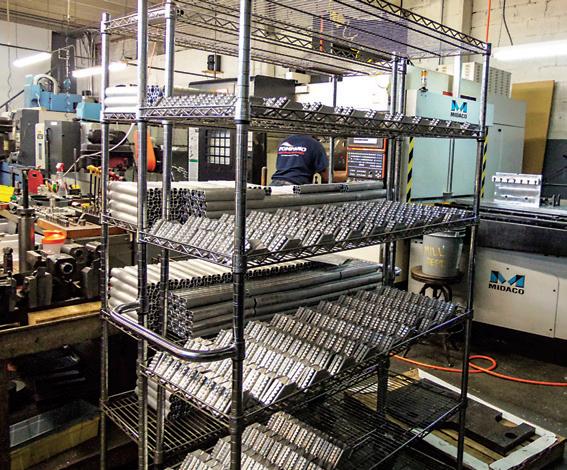
Overall, UM Tactical is a leading company in the firearms industry, thanks to its commitment to quality, innovation and customer service. As the company continues to grow and expand, it will undoubtedly continue to provide customers with exceptional products and services. If you’re in the market for gun accessories, UM Tactical should be at the top of your list.
Editor’s note: For more information, visit umtactical.com.




 STORY AND PHOTOS BY MIKE NESBITT
STORY AND PHOTOS BY MIKE NESBITT
The Black River Buffalo Runners just completed our sixth – as well as the biggest and best – annual Buffalo Camp series of black powder cartridge matches. This is still a rather small event but it is certainly growing, and this year we had some new participants. These new shooters added a certain amount of spice to the mix and they’re worth telling you about.
DAN JOHNSON HAS been shooting black
powder with us for over two years. His total shooting experience goes back many years, military and otherwise, but it was only recently that he ventured to the “dark side” and began seriously shooting with black powder. For Dan, it all began when he would volunteer to be our range safety officer for some of our Old West centerfire matches where he’d just watch. Then the scent of spent black powder penetrated his nostrils and that quickly led to more enjoyable involvement.
But Dan has a problem that we might call a limiting factor; he has old injuries
that prevent his shoulder from absorbing the blows from heavy-recoiling rifles. Those black powder cartridge buffalo guns can kick, maybe worse than shotguns. Therefore, Dan had to look for a black powder rifle that didn’t offer the recoil of a buffalo gun. Such was found in a copy of the good old Winchester Highwall chambered for the .44-40 cartridge, firing a 200-grain bullet at about 1,300 feet per second.
Dan had been shooting a shortbarreled copy of the 1873 Winchester, imported by Cimarron Arms, as well as a matching revolver, but the ’73 didn’t
have a rear sight that was quickly and accurately adjustable for setting the sight to various distances. So Dan acquired the .44-40 Highwall, equipped with a tang-mounted Vernier sight. This gun was everything he had asked for: a lightrecoiling but authentic black powder cartridge rifle that has what it takes for 200-yard shooting at our annual Little Quigley Match at Buffalo Camp.

The load Dan favors uses a 205-grain bullet over 34 grains of Olde Eynsford 1½F powder. He says that load gives him the performance he wants at both ends of the gun – out of the muzzle and at the butt plate – and I’d have to say that it is certainly working for him.
At this year’s Buffalo Camp, he made 10 hits on the gong, firing 15 shots over cross-sticks at 200 yards and another
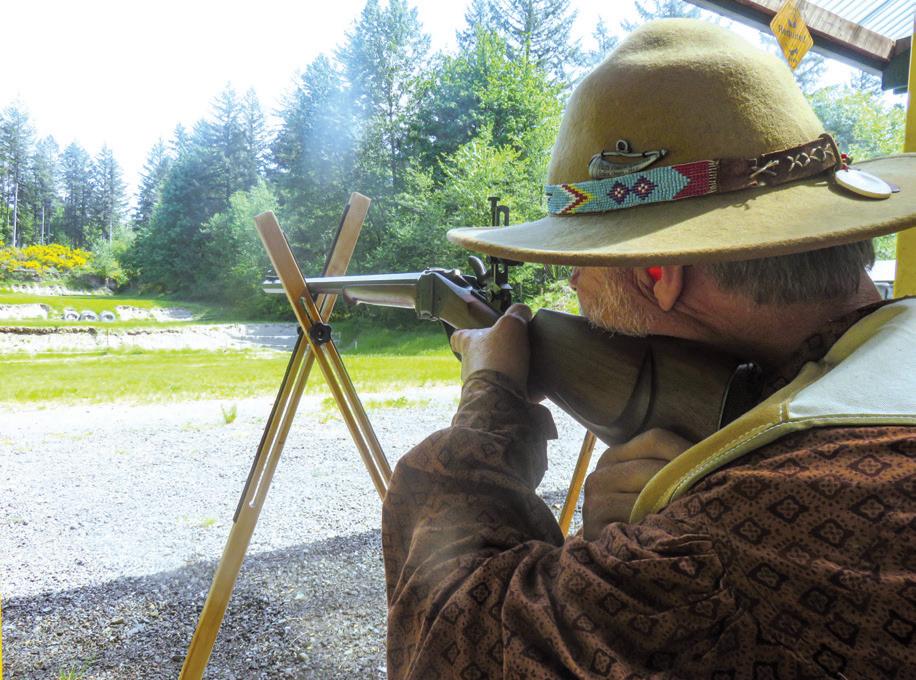

five shots offhand at 100 yards. Dan almost doubled my score, and placed sixth in the overall competition. That was simply very good, especially for his first time at this event.
ANOTHER NEW COMPETITOR at Buffalo Camp was Mike Holeman, but Mike is not a new shooter. I’ve known Mike for several years and over the course of those years, I have tried, teased and taunted him to join us for some black powder cartridge shooting. He would refuse me with an oath that he didn’t need to do that. Then I’d simply come back to him with the warning that once he did try black powder cartridges, he’d quickly learn how much time he had wasted by turning my offers down.
When Mike finally gave in, he became a monster! He couldn’t buy black powder cartridge rifles fast enough, then searched the Earth for brass and reloading tools. It all began with a C. Sharps Arms Highwall in .3855. That led to a custom rolling block
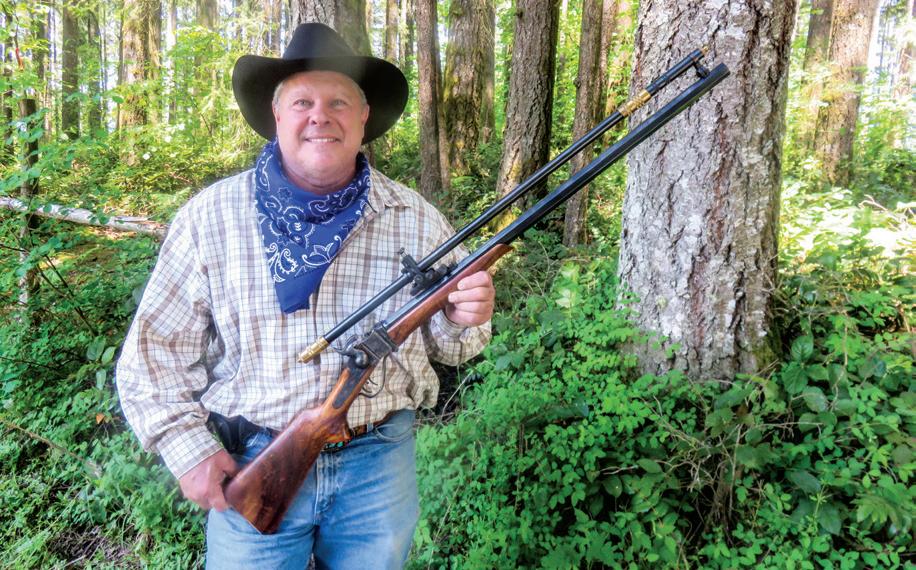
in .45-70. Then came his very nice 1874 Sharps Bridgeport Model from C. Sharps Arms, also in .45-70, and that’s the rifle he used to “make points” at his first try at Buffalo Camp.
We can’t say that Mike did anything wrong, but his fast and furious climb into black powder shooting might have set some records. In fact, watching his enthusiasm is tremendous, and it’s contagious! With only a little more time at the shooting bench, he might have done better in the match but that will come. Mike finished in 12th place overall and his fire of enthusiasm is still climbing.
Mike used 535-grain bullets loaded over 63 grains of Swiss 11/2 Fg powder, a very respectable loading, and his bullets were cast from Lyman’s No. 457132 mold, their famous Postell bullet. (Postell was a noted target shooter back in the 1890s and early 1900s.) With a start like that, Mike can easily expect to improve; in fact, we can count on it. By the way, he planned on trying
those loads at mid-June’s big Matthew Quigley Buffalo Rifle Match.
NOW I WANT to tell you about Jim Haeckel. I’ve been encountering Jim for at least a few years in the muzzleloading circuit, but it was just this past spring that he bought a Sharps in .45-70 caliber. He had expectations of using ammunition that he already had for his lever-action .45-70. It isn’t the easiest to explain, but while those rifles are chambered for the same cartridge, almost all shooters end up using different loadings in their two rifles, one for smokeless powders and another for black powder. Mixing the ammo usually is not successful for best performance.
But Jim learned fast. Now he loads his .45-70 with black powder, at least for his rather newly acquired Sharps. And he likes it that way.
Jim blazed a new trail for us at Buffalo Camp because he is the first to use a Sharps rifle with a telescopic sight (but he won’t be the last; I’ll do it next year!).
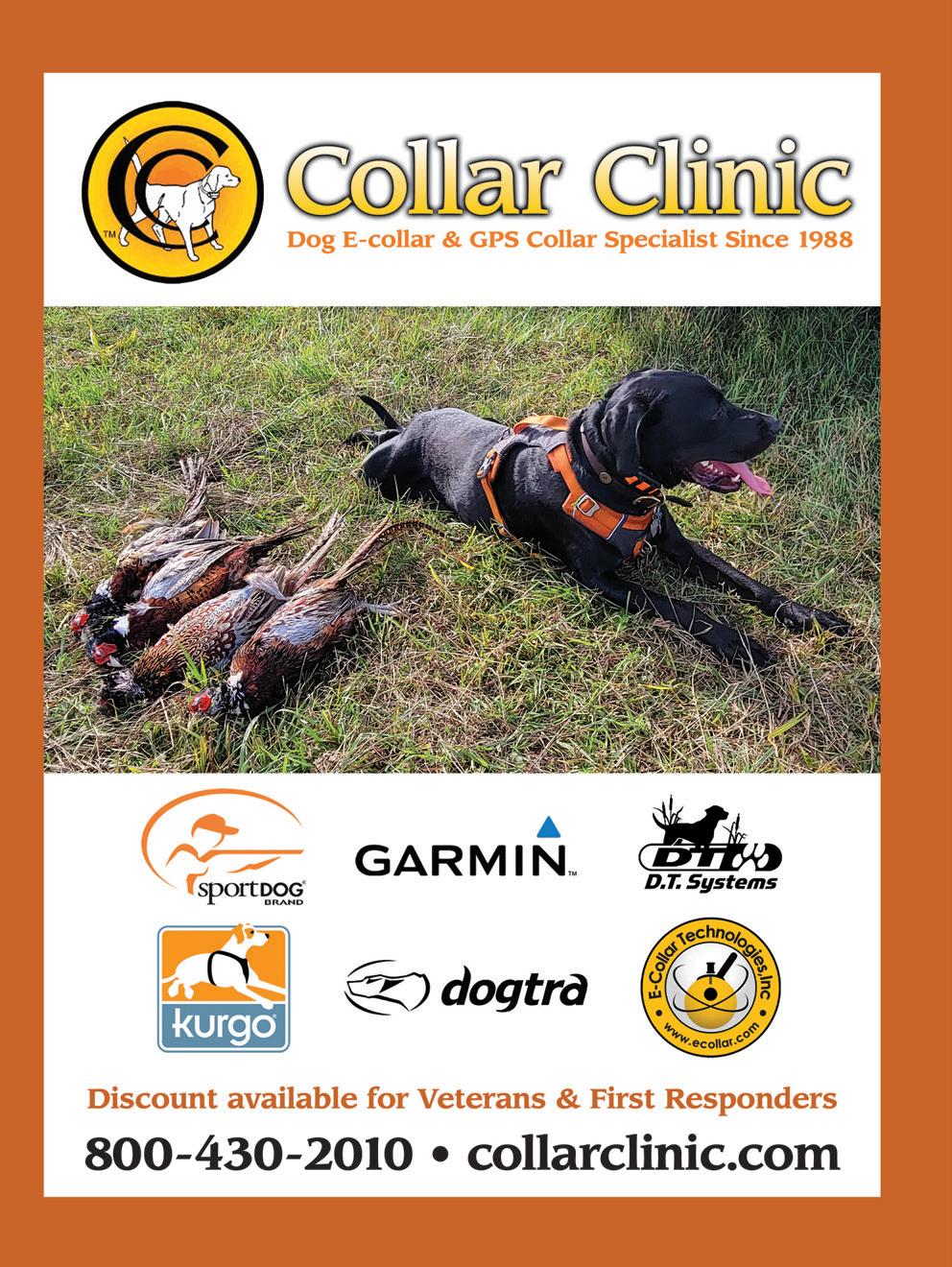

And for a first-time shooter, he did fairly well by getting 14 of the possible 20 hits on gongs in the Little Quigley Match and placing ninth in the overall competition, even dressing the part. Jim is somewhat like Mike Holeman: when you get hooked, you’re hooked! Jim has already re-stocked his Sharps with some very pretty wood and you can bet that he’ll be adding to his “Sharps collection” as opportunity allows.
THE NEXT NEW shooter I want to tell you about is a rather special one. Ryan is the 13-year-old son of “Doc” Ritter. At our recent Buffalo Camp, Ryan came with his dad and they camped just a little ways from where Mike Moran
and I were camped. On the Saturday morning of Buffalo Camp, when we hold the Little Quigley Match, Ryan mainly observed, staying close to his dad and possibly doing some of the “spotting” for his father.
At that match’s conclusion, Doc came to me and asked if a special target could be posted because Ryan was interested in trying a rifle. Well, certainly! Actually, two targets were posted, one at 100 yards and another at 50 yards, to give Ryan the chance to get his eye trained for making good hits. I don’t know if Ryan ever tried his father’s .45-70 custom Hartford Sharps, which has a crescent butt plate. To give
the boy a better starting chance, Dan Johnson had him shooting the .44-40 Highwall. That fit right in!
To give Ryan more shooting with a rifle that was more appropriate in fit and style for him, I just happened to have my ’73 Trapper carbine in .44-40 along. Ryan used that Trapper carbine on a paper target and once he got the feel of it, he and his dad went down the Meat Hunt trail for more good shooting. I was told that on the trail, Ryan excelled! The only thing that Ryan had to ask for was more ammunition!
The Meat Hunt, which I have mentioned in the past, is a trailwalk where animal- or game-shaped
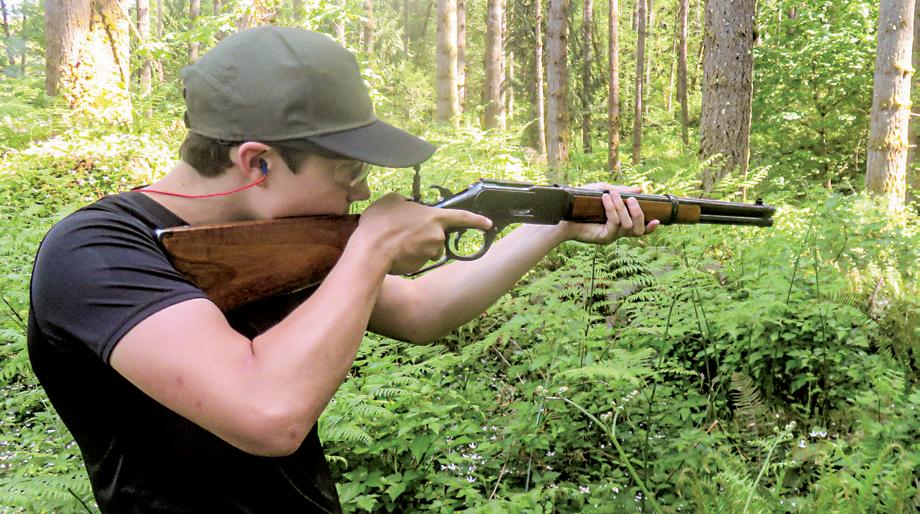

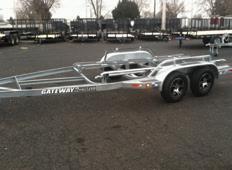



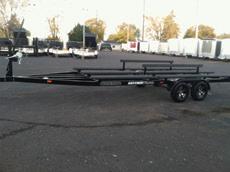
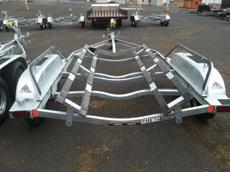




silhouettes are hung at various nonnoted distances to make it like a real hunting experience. Rather than buffalo guns, we use our “camp guns” for this and the .44-40 is a popular choice. A total of just 15 targets are on the trail, plus a tiebreaker, which means there are 16 shots fired while on the Meat Hunt. A lot of our shooters consider the Meat Hunt more fun than the Little Quigley Match, and fun is our only purpose for holding these events.
AND IT'S BEEN fun for me to simply tell you about these four new shooters at Buffalo Camp. They were the real highlights of the event, even more than the winners and high-scoring shooters, and we can certainly expect to see them again in the coming years. Now, let me make a quick offhand prediction: I’m just guessing that when Ryan comes back, either next year or the year following, that he might have his own rifle and he’ll outshoot his dad!



